BUBBLE TEA
Horror is served...
The latest fad among the very youngi
ALCOHOL-FREE WINES
A growing trend with producers bracing themselves
WE HAD DELIVERY CONTAINERS TESTED: HERE ARE THE SHOCKING RESULTS

BUBBLE TEA
Horror is served...
The latest fad among the very youngi
ALCOHOL-FREE WINES
A growing trend with producers bracing themselves
WE HAD DELIVERY CONTAINERS TESTED: HERE ARE THE SHOCKING RESULTS


Big gulp 4.0. A strange story in full colour

The (non) fashion of alcoholfree drinking . Don’t call it wine!
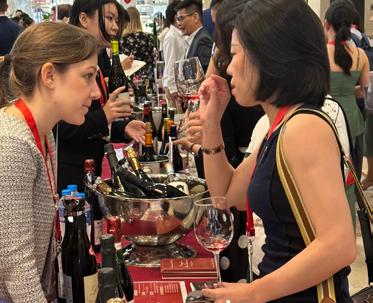
Chef: Andrea Antonini to the test of 9







Would you eat a sandwich or pizza on the restaurant floor? This is the rhetorical question posed by our own Maurizio Gaddi in his investigation into the sensational (but unfortunately not unbelievable) fiasco discovered in the food delivery chain.
We had food delivery riders give us the bags they had been using all day at the end of their shift, and which we took to the lab for testing. They turned out to be riddled with bacteria. To be clear: if NAS (department of the Carabinieri responsible for sanitary controls of foodstuff, drinks, medicine operating under the Ministry of Health) found a sanitary situation on the floor of a restaurant like the one we found in the bags given to us by the riders, the restaurant would be instantly shut down. So we investigated a bit. We discovered that the contract that binds the workers to the platforms that own the algorithms stipulates that the burden of cleaning and sterilising the bag is on the rider and not on the employer.
The outcome is written in the premise: the rider, one can almost see him, exhausted by the kilometres travelled during an endless day spent frantically fulfilling orders on his mobile phone, arrives at the end of his shift, and instead of ‘cleaning with soap, washing, disinfecting and rinsing with paper and finally drying’ - as hypocritically stipulated in the contract drawn up with the multinational company - hurls himself in the bed of his room shared with who knows how many other ‘colleagues’.
A macroscopic and scandalous one-way buck-passing of responsibility, from the top down. Or rather from the very top to the very bottom. As for the consumers - customers? citizens? users? call them what you will, you can’t, or rather we cannot call ourselves out of it - as for the consumers, as we were saying, they have no choice but to return to the fatal and now almost daily dilemma: do they give up ordering takeout so as not to feed an ‘algocratic’ (i.e. algorithm-driven) system, as the Americans would call quasi-slavery, and - at this point - even dangerous? Or continue to not giving a damn by leaving an extra fifty cents tip before plunging headlong into their sushi? There is, however, something more revealing than our dilemmas. And it is the second rhetorical question posed by the survey that Gambero Rosso has chosen to feature on the cover: how much longer will we have to wait before the whole sector is placed under the umbrella of sensible, safe and, above all, fair regulation?
PS: In this issue Michela Becchi and Marzio Taccetti also tell us about a colourful and somewhat disturbing phenomenon: bubble tea . A fashion that is spreading very rapidly, especially among the younger generation. Well, we went to the most popular bubble tea joints and asked to have a look - as required by law - at the ingredient lists of the products used to make the mixtures. They were not displayed anywhere and we were turned away. Talk about sensible, safe and fair regulations.
– Marco Mensurati
average retail price: Euros 65

Maurizio Zanella is one of the brightest visionaries of Italian wine. He’s managed to transform what was once the summer vacation home of his mother, Annamaria Clementi, into a hub of innovation and true excellence. Most of the winery is owned by the Gruppo Santa Margherita, while in terms of winemaking, the producer relies on the support of highly-acclaimed enologist Stefano Capelli. The extremely modern production facility, which features sophisticated technology, fine hospitality and works of art, is tucked away amidst woods and vineyards, and it’s definitely worth a visit.
We felt in love with the Franciacorta Vintage Collection Dosage Zéro 2018. The palate traces a very wide arc, with ripe fruit counterbalanced by a tasty, sapid vein and a characterful finish rich in contrasts. It reaches a peak of excellence for its consistency, balance and the finesse of its smoky weave. We strongly believe the 2018 vintage is a truly 5 stars vintage in the Franciacorta area. Food pairing? Pair it with a proper risotto alla Milanese (saffron risotto) for a creamy and tasty match!

Where nature, sustainability, art and hospitality are inextricably linked. A small paradise, an authentic place in Torgiano, in the green heart of Italy, Umbria.

 TORGIANO ORGANIC WINE
TORGIANO ORGANIC WINE




2.5

1.5 cl Sugar syrup
1 cl Ruby port


1 cl Sherry Amontillado
2 drops Stillabunt Magic
sour inspiration, My Sweet Rye is made with two products dear to me: one is Bourbon Whiskey to which I am particularly attached because it was my first love at the beginning of my career, the other is Sherry, a product valued and little used in mixology which I became passionate about during one of my professional training trips. The drink starts with a base mix of Sherry and Port, whose gustatory aroma recalls ripe black cherries, a fruit of this season that I particularly love. The sour base drink is built on this, which we pour onto ice trying not to combine the two compounds, which are later combined to obtain two completely different flavours in the same drink.»
Greco, born in 1972, was born in Milan and began his career in the bars of the Romagna coastal towns. In 2001, the year in which he attended Flair Academy, he began to study and participated in specialisation courses. In the meantime he made himself known in some of the most important bars of the Milanese scene until 2008, when he arrived at the Buvlgari Bar of the Bvlgari Hotel Milano, where he stood out for his professional approach and his creativity. Since 2013 he has assumed the role of Bar Manager and, in recent years, he has also worked as a trainer for the teams of the new Bars of the Bvlgari Hotels inaugurated in Beijing, Dubai and Shanghai. Today he's at the helm of the Bvlgari Bar in Milan, awarded as one of the
It was 1998 when siblings Maria Iris Bertarelli and Claudio Tipa decided to bet on their passion and make their common dream come true. The purchase of some vineyards in the deepest part of Tuscany, in Cinigiano (39 kilometres from Grosseto), represents the first step in this direction. Castello ColleMassari was born, which stands on the slopes of Monte Amiata, in Maremma, land of extraordinary and uncontaminated beauty. «When I arrived here, in ‘98, I immediately saw the possibility of realising my dream and returning to my origins: our maternal grandparents, in fact, had a property with vine -
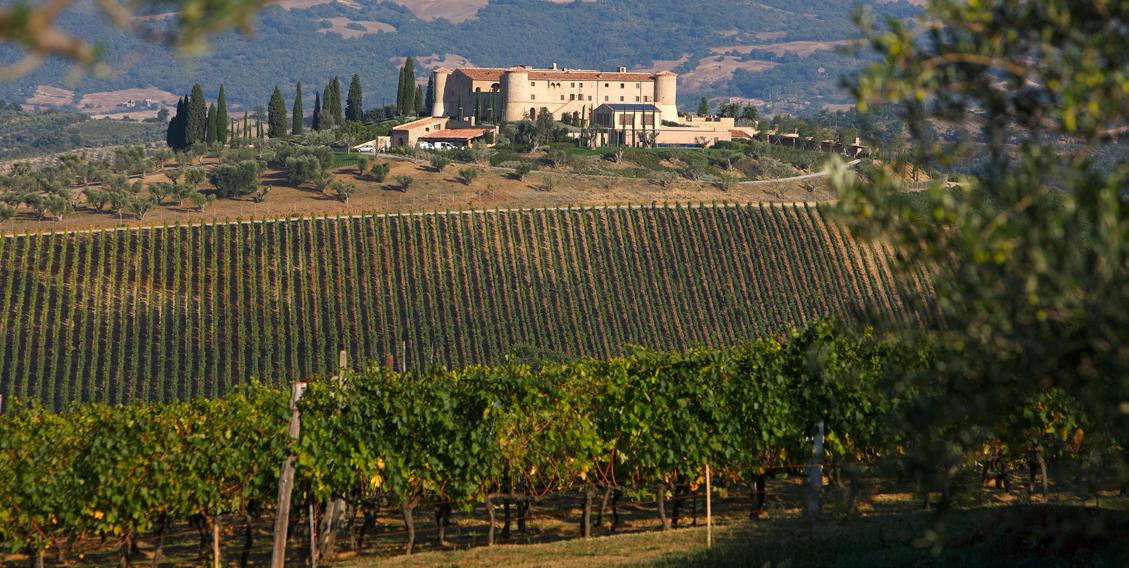
yards and olive groves in Tunisiasays Claudio Tipa - From the original hectare of vines, I immediately planted others up to the current 120 and I built a modern designer cellar, dug into the rock almost 20 metres deep». The vision was to respect and enhance the territory, to establish new quality standards with the help of technology and a strong team. «Tradition teaches us respect for the grapes and the wine, while technology allows us to better manage the production process - says Giovanni Puccioni , the company’s oenologist - They are not things in contrast, on the contrary, there must be this in-
teraction to obtain the maximum quality products.» Today the extension of the company covers approximately 1,210 hectares and the cellar is surrounded by a rich biodiversity in which vineyards, olive groves, arable land and woods alternate. «All these elements make it possible to carry on an authentic organic cultivation, favoured by the interactions of all the different vegetables,» explains Puccioni. Another fascinating aspect of the cellar is that it was designed and built by architect Edoardo Milesi according to the dictates of bio-architecture and biodynamic engineering. «The cellar is struc-
tured vertically on three levels: we move the grapes and wines without pumps. The advantage is double: we treat the grapes in a more delicate way and it improves the final quality of the product. Furthermore, not having to use electricity, increases the sustainability factor.» Three cultivated varieties, Vermentino and Sangiovese are the ones that best express characteristics of uniqueness. “We are in a middle strip between the sea
and Mount Amiata, influences that favour the ripening of the grapes. Vermentino acquires a beautiful aromatic expression, but also a good structure and acidity. On the other hand, the Sangiovese that we grow comes from old clones that we rediscovered and selected because they are the authentic expression of the territory: an important Sangiovese, whose power is managed in order to obtain an elegant product.



It is the symbolic wine of the estate. Powerful in the mouth, with a remarkable complexity and freshness, its structure is elegant and enveloping and a valuable longevity is added to the gustatory integrity. A base of Sangiovese, which gives notes of fruit and spices and good acidity, is accompanied by Ciliegiolo and Cabernet Sauvignon, which makes it immediately palatable. The dictates of organic farming and the characteristics of the soil, the vinification in small vats with spontaneous fermentation and long maceration, the ageing in large wood barrels: all of this helps to preserve the expressive authenticity of the local grapes.

Gambero Rosso’s Street Food 2024 guide, the only national (and updated) map of Italian street food, is now available at newsstands and bookshops. In over 500 locations, an account of street food from North to South with an appendix entirely dedicated to food trucks. New: in-depth coverage of markets and food courts, increasingly interesting places for fans of the segment. The special Street Food da Chef award goes to the Panino da spiaggia by Pascucci al Porticciolo in Fiumicino (RM) (pascuccialporticciolo.it)
Courmayeur (AO)
Pan per Focaccia
Torino
Mei Shi Mei Ke
Milano
Katsusanderia
Lavarone (TN)
Chalet Cimone
Vicenza
Il Bacaro della Pizza
Trieste
aMano
Bologna
Indegno La crescentina 2.0
ABRUZZO
Castel del Monte (AQ)
Ristoro Mucciante - ristoromucciante.com
BASILICATA
Avigliano (PZ)
Retrò...Gusto - fRetròGusto StreetFood
CALABRIA
Scilla (RC) - Civico 5 - civico5.eu
CAMPANIA
Pomigliano d’Arco (NA) - Is Pop - ispop.it
EMILIA ROMAGNA
Bologna
Indegno La crescentina 2.0 - indegno.eu
FRIULI VENEZIA GIULIA
Trieste - aMano - famanotrieste
LAZIO Roma
Grasso Fish Burger - grassofishburger.it
LIGURIA
Genova - Rooster - roosterrotisserie.com
Rooster Genova
Pontassieve (FI)
A Pancia Piena
Spoleto (PG)
Serafino's Porchetta
San Benedetto del Tronto (AP)
Gastrò
Castel del Monte (AQ)
Ristoro Mucciante
Iallonardi Isernia
LOMBARDIA Milano
Katsusanderia - katsusanderia.com
MARCHE
San Benedetto del Tronto (AP)
Gastrò - fGastró
MOLISE
Isernia
Iallonardi Sapori Autentici - iallonardisalumi.it
PIEDMONT
Torino - Mei Shi Mei Ke - fMEI SHI MEI KE
Taquito Cagliari
Roma
Grasso Fish Burger
Pomigliano d'Arco (NA)
Is Pop
Ragusa
Delicatessen in drogheria
Putignano (BA)
Salumeria Bianco
Avigliano (PZ)
Retrò...Gusto
Scilla (RC)
Civico 5
PUGLIA
Putignano (BA)
Salumeria Bianco - salumeriabianco.it
SARDINIA
Cagliari - Taquito - taquitocagliari.it
SICILY Ragusa
Delicatessen in drogheria - delicatessenragusa.it
TUSCANY
Pontassieve (FI)
A Pancia Piena - fApanciapienasieci
TRENTINO ALTO ADIGE
Lavarone (TN)
Chalet Cimone - cenainbaita.com
UMBRIA
Spoleto (PG)
Serafino’s Porchetta - fSerafinoS-Porchetta
VALLE D’AOSTA
Courmayeur (AO)
Pan per Focaccia
fPan X Focaccia Courmayeur
Street Food 2024

pp. 240 - € 9,90
available online on gamberorosso.it
VENETO
Vicenza
Il Bacaro della Pizza - bacarodellapizza.com
The stories that revolve around oysters are many, often even fake, such as the one that they must be eaten in one gulp or the one that lemon drops must be added to kill bacteria. Then there is the one that they should only be eaten in months containing the letter ‘R’ (in French, though).
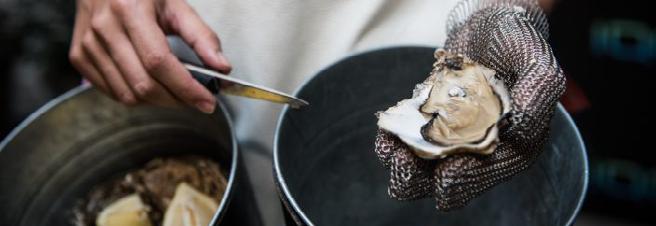
There is some true news, however: like that, for example, that ‘wild oysters’ will never be found on our tables and that they are very ecological molluscs. According to the US National Oceanic and Atmospheric Administration, in fact, a single oyster can filter 50 litres of water a day; moreover, they do not need induced substances to feed themselves and are therefore also considered sustainable. If this storytelling fascinates you, then welcome to the fabulous world of oysters! And, think about it, you can even specialise in their knowledge and become a sommelier, or an oyster master.i.
Just as for wines we speak of terroir, for oysters we speak of merroir, a term
used to define the set of characteristics of the environment in which the oyster grows such as salinity of the water, gaseous content dissolved in the water, temperature. “The oyster expert has all-round knowledge about this world, not only about tasting and organoleptic aspects, but also about species, history, food safety and farming techniques, as well as diseases. The oyster sommelier represents an added value for the restaurateur because he knows how to handle oysters, he knows how to propose them, he knows the method of preservation and the best period to buy them,” says Alessio Cutino, restaurant entrepreneur and founder together with Daniela and Simone Testa of Aiost (Italian Oyster Association).
The sommelier is basically an intermediary between the distributor and the restaurateur and between the latter and the end customer: he knows the oysters and can recognise the best ones, he knows how to treat and serve them.
1 Purchase. It is only possible to market farmed oysters. «As with wine, there are also distributors for oysters. Generally, the expert does not go to the oyster farm in person, but obtains supplies from a distributor who gives the distributor the information allowing to taste the product,» explains Francesca Lugli, a partner at Red Oyster, an oyster sommelier company that organises events, catering and training.
2 Training. Oysters are delicate molluscs; the sommelier is responsible for training the staff: correct storage, hygiene standards, service. For example, oysters can be refrigerated for a maximum of 1012 days and should always be opened with a knife and glove.
3 Storytelling. Without a story, you are nobody today. The sommelier can tell the restaurant guests about the product in great technical detail.
Although still little known, the figure of the sommelier is becoming increasingly popular. There are at least a couple of valid courses to approach this profession. On the heels of the pandemic, AIOST was set up in Campania, the first non-profit association of oyster sommeliers with course headquarters at Rione Terra in Pozzuoli (NA). The aim of the course is to qualify professionals who are able to take care of oysters from A to Z with training comprising three levels. It takes about a year and a half to complete the three levels - just like wine sommeliers. The other oyster course is by Red Oyster, the brainchild of Mariangela and Francesca Lugli, who also organise a specific course in collaboration with Gambero Rosso and aimed at food and wine professionals. A three-day full immersion course to get a basic knowledge of the subject.
4 Tasting. The sommelier can taste the oyster with the customer: from the visual examination in which the presence of water and brilliance (bright or dull colour) is assessed to the olfactory examination. «The oyster must be reminiscent of the sea, if the scents are different, there’s something wrong,» explains Francesca Lugli. The oyster, moreover, should not be swallowed whole, but tasted: chew it, take a sip of wine, chew it again.
– Antonella Dilorenzo5 Pairings. Depending on the oysters chosen (more or less savoury or sweet or iodised), the sommelier will be able to recommend pairings: wine, but also other beverages (such as beer or whisky, preferred in Northern Europe)
Risotto with saffron, mondeghili, cassoeula: the best-known dishes in the Lombardy recipe book mostly have to do with the photograph of the “old school Milan” trattoria and in the collective imagination remain linked to the tradition of the Lombardy capital. In reality, however, this is only a small part of the rich and eclectic basket that a region as extensive as Lombardy holds in its collective memory and daily traditions. For this reason, the best interpreters and promoters of such a rich and not sufficiently known basket - between “great oldies” with decades of glorious activity behind them and young “countertrends” that travel in the present with roots planted in the past - are the twelve restaurants, one for each provincial capital, awarded in the Lombardy - The Best of Milan and Other Provinces 2024 guide (to be published at the end of the year) as Ambassadors of the Territory. This is an acknowledgement that Gambero Rosso has been awarded for several editions to the efforts made by chefs and patrons in protecting, promoting and treating the best of both local products and the most representative dishes of their respective areas, each with its own style and philosophy. An army of small-big “heroes” that, as we were saying, includes in its ranks some very different realities that are, however, united by the same philosophy. These realities will also be the protagonists, starting in September 2023, of a dinner tour aimed at enhancing Lombardy’s heritage and offering participants an “immersive” experience in its many facets.
MILAN
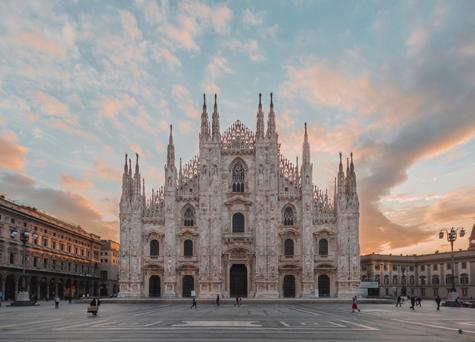
Trattoria Sincera – via A. Porpora, 154
389 874 1577 – trattoriasincera.it – chef Federico Boni
BERGAMO
Osteria Al Gigianca – via Broseta, 113 035 5684928 – algigianca.com – chef Andrea Paleni
(patron Luigi Pesenti e Alessia Mazzola)
BRESCIA
Osteria dell’Orologio – Salò (BS)– via Butturini, 26 0365 290158 – osteriadellorologiosalo.eatbu.com
chef Marco Giacomini
COMO
Tira Mola e Meseda – via G. Castellini, 17 031 2759735 – tiramolameseda.it
chef Patrizia Cimadoro
CREMONA
Caffè La Crepa – Isola Dovarese (CR)
p.zza G. Matteotti, 14 – 0375 396161 – caffelacrepa.it
chef Matteo Marini (patron famiglia Malinverno)
LECCO
Antica Osteria Casa di Lucia – loc. Acquate via Lucia, 27 – 0341 494594 – osteriacasadilucia.com
chef Carlo Piras
Lecco
Antica Osteria Casa di Lucia
Tira Mola e Meseda Como
Malnate (VA)
Crotto Valtellina
Monza
Osteria del Cavolo
Milano
Trattoria Sincera
Canneto Pavese (PV)
Bazzini
LODI
Villa di Chiavenna (SO)
Lanterna Verde
Bergamo
Osteria Al Gigianca
Salò (BS)
Osteria dell’Orologio
Castiglione delle Stiviere (MN)
Hostaria Viola
Ca è La Crepa Cremona
Lodi
Antica Osteria Del Cerreto
Antica Osteria Del Cerreto – via dell’Abbazia, 6 0371 471009 – osteriadelcerreto.it – chef Stefano Scolari
MANTOVA
Hostaria Viola – Castiglione delle Stiviere (MN) – via G. Verdi, 32 0376 670000 – hostariaviola.com – chef Alessandra Viola
MONZA-BRIANZA
Osteria del Cavolo – Monza – v.lo Molini, 11 – 039 322060 osteriadelcavolo.it – (patron Emiliano Genoncelli)
PAVIA
Bazzini – Canneto Pavese (PV) – via Roma, 11 – 0385 88018 ristorantebazzini.com – patronne Mariella Mariotti
SONDRIO
Lanterna Verde – Villa di Chiavenna (SO) – fraz. San Barnaba, 7 0343 38588 – lanternaverde.com – chef Roberto Tonola
VARESE
Crotto Valtellina – Malnate (VA) – via Fiume, 11 – 0332 427258 crottovaltellina.it – chef Leonardo e Roberto Valbuzzi
At Cappadonia, don’t miss the giandujone and stracciatella (but the fruit gelato is great too). But be careful: in general, at gelaterie in Palermo, try pistachio and almond, perhaps accompanied by the classic brioche bun. Here are the 7 best gelato shops to try in the Sicilian capital.
1 BarConi
Via Benfratelli, 7 – 091 2710285 – fbarconi.bar
2 Cappadonia Gelati via Vittorio Emanuele, 401 – 392 5759351 – cappadonia.it
3 Galatea
Mondello – via Galatea, 57 – 091454653 - fbargalatea57
4 Latteria Gelati Cremosi
Via L. Ariosto, 20 – 3248887822 - flatteriagelaticremosi
5 Al Gelatone via dell’Autonomia Siciliana, 96 – 091363604 – algelatone.it


6 Il Signor di Carbognano via E. Notarbartolo, 2c 0917302545 - ilsignordicarbognano.it
7 La Vela piazza Bordonaro, 10 – 091361860 – fGelateriaLaVela
FAKE ICE CREAM CONES IN TIFFANY BLUE BOXES
Six sweet morsels handmade by the maîtres chocolatiers of T’a Milano, the pastry brand of the Alemagna brothers, enclosed in an elegant Tiffany blue box with ice cream cone designs. In fact, the sweets look just like ice cream cones, but in reality they are crunchy chocolate spheres enriched with a creamy interior and then applied to wafer cones. Original desserts with a surprise hidden in a package reminiscent of those found in jewellery shops. Perfect to serve after dinner in summer

PUGLIA. POLIGNANO A MARE: LUXE VACATIONS

Freshly opened to the public, Masseria Aura Terrae is a new hospitality location right in the town where the unforgettable singer Domenico Modugno was born. It is an ancient 17th century farmhouse perched on a hill, in a panoramic position, surrounded by green olive trees and 24 hectares of land, owned by the Valentini family, well-known and eclectic entrepreneurs in love with their land. A long and loving restoration has created a luxury hotel, ideal for a holiday in the establishment of relaxation and psychophysical well-being. There are 22 rooms, of different categories, each with its own particularity, all with an outdoor space, whether patio, terrace or balcony. Among the many services available, two infinity pools, bicycle hire, shuttle to/from the centre, and an excellent breakfast.
At the Mareincielo restaurant, the talented chef Antonio Gentile expresses himself with judicious creativity using mostly local ingredients, from fresh fish to extra virgin olive oil and vegetables from his own biodynamic garden, following the principles of the Mediterranean diet and sustainability. For dinner there are two tasting menus, Tradition and Innovation meets Tradition”. A few examples: red tuna, buffalo, cherry tomato and hazelnut cream; spaghettone with sea urchin and tomato water; sea bass cooked in vine leaves, aquasale, smoked celery and almonds. All accompanied by a well thought-out wine selection, with references from small regional producers alongside national and transalpine labels.
Masseria Aura Terrae
Polignano a mare (BA) - viale Maringelli, 404 + 39 080 995566 - masseriaauraterrae.com
VALDO ATELIER: A COLLECTION OF UNIQUE MASTERPIECES, PRODUCED EXCLUSIVELY WITH THE GRAPES OF THE HISTORIC GRAPE GROWERS OF VALDOBBIADENE AND MADE SPARKLING THROUGH A LONG AGING ON THE LEES OF AT LEAST 5 MONTHS.
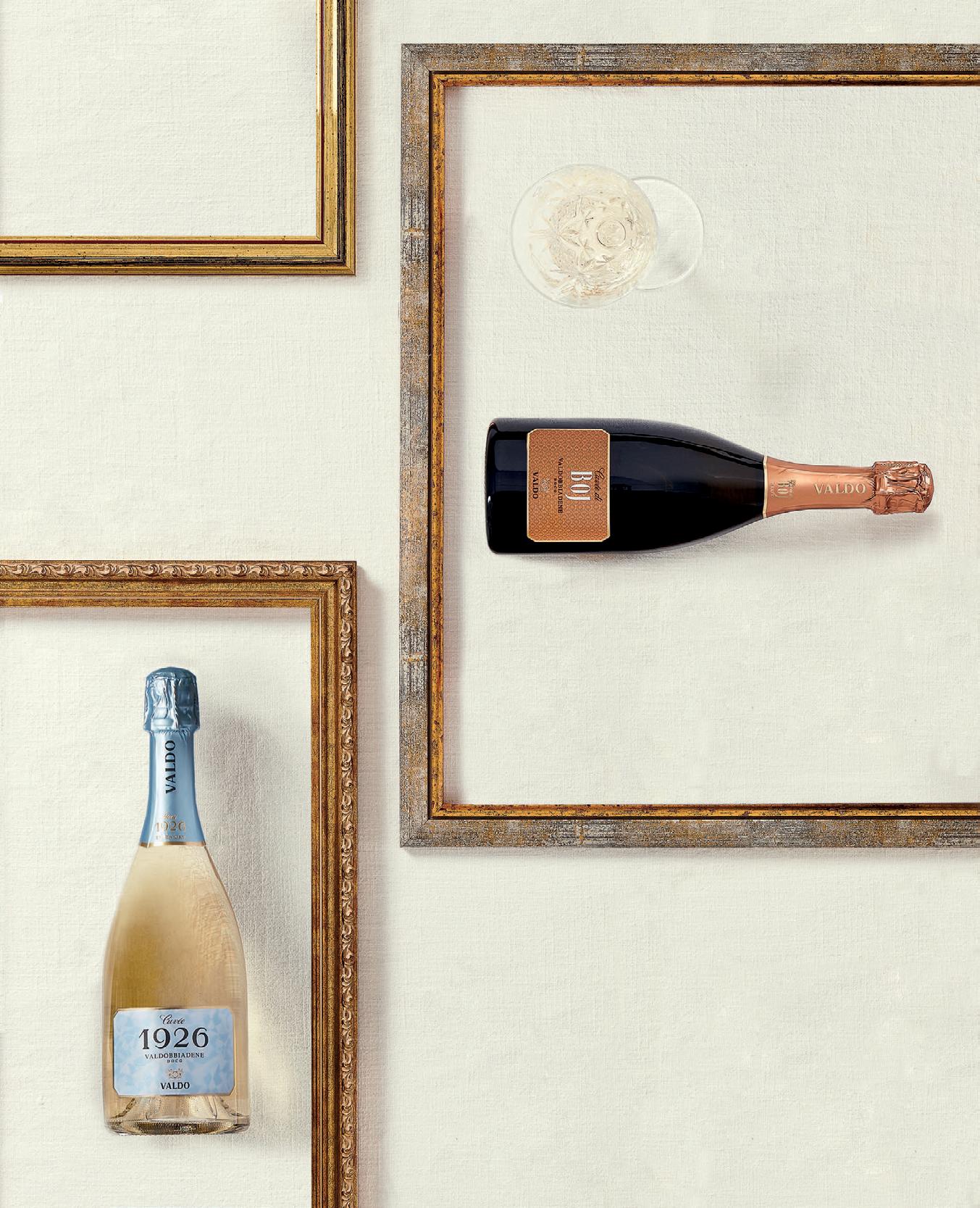

Valdo, a name that immediately recalls the territory to which it belongs, Valdobbiadene. A name inextricably linked to the Bolla family, which has been in the wine business for more than 90 years. Considered among the oldest in the area, over the course of three generations it has been able to spread the culture of Prosecco in Italy and around the world.
What are the strengths that have decreed the company’s success?
Family tradition and passion for wine, respect for the territory and above all the vision and ability to innovate in the winery and intercepting trends before others and creating unique sparkling wines: reducing sugar
dosages down to Brut with BOJ’s Cuvée since the 1980s, creating Prosecco Superiore DOCG with more structure using barrique and chardonnay as in the Cuvée del Fondatore or even “challenging” Prosecco’s Glera grape with the classic method, being among the first to make a Valdobbiadene Prosecco Superiore DOCG with the classic method in the early 2000s that is now sold and appreciated in Italy but also abroad.
In recent times, Cantine Valdo crosses national borders with the creation of Valdo Europe and Valdo USA, can you tell me about them?
Starting with overseas news, the company has entered into a distri-
bution agreement with the Mondavi family in California that owns Charles Krug Winery, founded in 1882-the first winery built in Napa Valley. The collaboration, specifically, will be developed in three phases. The first, starting in January 2023, will involve the distribution of Valdo products in the U.S. market, which currently generates 5 percent of the company’s revenue, 50 percent of which is generated from Italy, with approximately 20 million bottles. The second phase involves the establishment of a 50-50 joint venture based in California that will import and distribute in the United States “the best Italian wine production,” developing a portfolio of
Valdo,
and beyond brands of excellence. Valdo, by the way, already serves as importer, but in Italy, of Nicolas Feuillatte and Gérard Bertrand’s Côte des Roses brands. The third phase, for which the first steps will be taken within the year but will see development in the following, will result in the establishment of an additional 5050 joint venture based in Carneros, Napa Valley, which will focus, in this case, on producing wines and sparkling wines.
Sustainability: why is this a hot topic for the company? What are the activities you have carried out and are carrying out regarding it?
Sustainability is an inalienable value for the Bolla family and therefore for VALDO the culture of sustainability is behind every effort of reducing the consumption of plastic and water improving the winery carbon footprint.
Valdo in 2021 has covered the roof of the new winery with solar panels producing almost 70% of the energy absorbed by the plant.

Parallel projects: Valdo is not only sparkling wines, but also still wines and importer of excellence: the Magredi Wines and the champagne distribution Nicolas Feuilatte and Gerard Bertrand’s Cote des Roses brand how do these projects come about and what is the goal?
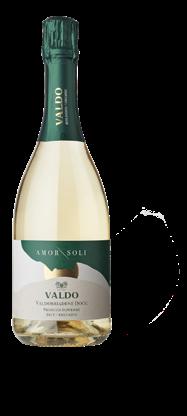

Innovation and terroir outline the profile of this sparkling wine. Glera grapes meet chardonnay partially aged in barriques. A vintage of great elegance that tells of the spirit of the winery that always keeps an eye on the future, experimenting and trying to renew products to meet contemporary tastes. Hazelnut, vanilla and a hint of honey combine with ripe fruit sensations. Sensations that dominate on the nose and in the mouth. A wine meant to be a tribute to the company’s founder Sergio Bolla.
The first organic Prosecco Superiore produced by the winery, more than a simple sparkling wine it is an oenological project in which sustainability, love for the territory are guidelines of a path that go along with the philosophy of the winery that wants to give something back to that territory that has given so much to the Bolla family from 1926 to today. A wine with intense aromas of fruit and white flowers that break away from a mineral undercurrent. Delicate, elegant and with great freshness, it gives a savory and persistent sip
They are strategic partnerships born in Italy with Magredi to




The Champenoise Method gives this prosecco superiore great olfactory richness and complexity. The carefully se lected glera, verdiso, bianchetta and perera grapes come solely from the Tenuta Pradase vineyard, the winery’s nerve center and a representative plot in the Valdob biadene area. After refermentation, the wine rests on the lees for a period of no less than 24 months, resulting in a sparkling wine that recounts the tradition of yester year through the blend, but stands out for its complexi ty and taste.


Rive
The term Rive indicates a steep and craggy terrain particularly suited with regard to the cultivation of vines from which high quality grapes are produced. A vintage and Extra Brut sparkling wine, which is produced in a limited edition of only 17,852 bottles, it has intense floral aromas with slight citrus nuances and a dry mouthfeel of great complexity and richness on the palate with savory and mineral notes and a very persistent finish.
 di San Pietro di Barbozza
di San Pietro di Barbozza
integrate the wine supply chain and with Gerard Bertrand and Nicolas Feuillatte to broaden our distribution both in Horeca and in large-scale distribution by bringing foreign excellence to Italy. Valdo’s aptitude for innovation is also expressed through a mindset open to the development of strategic partnerships with important winemaking realities at the international level. Regarding Italy, in 2018 Valdo acquired a stake in the I Magredi winery, known for its Circular grape variety and its fine Friuli Grave DOC wines from the Domanins area in the province of Pordenone. Last Vinitaly, Valdo introduced an extraordinary novelty, the new line of still wines “Le Tenute Valdo,” which marks a new development in the collaboration with the Friulian company. A great oenological work was carried out to create five new labels - 2 red (Merlot and Cabernet Sauvignon) and 3 white (Pinot Grigio, Ribolla Gialla, Sauvignon Blanc). A real revolution for a company that has been dedicated exclusively to sparkling wines for almost 100 years.



The escalator tax and the new guidelines limiting alcohol consumption have not stopped the thirst for Italian wine in Canada: rewarding the Beautiful Country is its vast ampelographic heritage.
Bubbles, organic wines and native grape varieties are the most appreciated. Reporting from the last summer leg of the Gambero Rosso World Tour

After a long and intense tour, lasting almost a year, which took a large and qualified representation of Italian oenology around the world, the time has come to draw conclusions. For more than 10 months, organisers of the Gambero Rosso events and the journalists associated with the Vini d’Italia guide accompanied wineries across the globe (Japan, Australia, Brazil, South Africa, the United States, Korea and, of course, the main European countries) with one mission in mind: to put the excellence of domestic wines in contact with buyers, the press and restaurateurs from the aforementioned nations, to promote the best of our production.
The summer finale, with a nine-day tour, was ‘entrusted’ to Canada - from Vancouver to Montréal, passing through Toronto - where Italian wine is enjoying a happy moment, despite the rather heavy taxes on wines.

In particular, 2022 was a record year for Italian wine in Canada, with an export value of 427 million euros, up 11% on 2021 and well above pre-pandemic levels (342 mln/euro), thanks above all to sparkling wines (60 mln euros, compared to 40 mln in 2019), driven by the rise of Prosecco among the preferences of Canadian consumers, and bottled wines (+10.5% to 347 mln euros), especially PDO wines. This result, for the whole of 2022, was achieved with the same total volume of wine exported as in 2021, at 80 million litres. Predictable, therefore, is the decrease in the first three months of 2023, when Italy shipped 80 million worth of wine to the Canadian market (around 20 million less than in the same quarter of 2022).
Then there was another factor that affected the start of the year in no small measure: the escalator tax, which was expected to rise by 6.4% due to out-of-control inflation. In April, fortunately, the Ottawa government decided to set a 2% limit on the annual adjustment of the excise tax on alcohol.
The intervention brought a sigh of relief to the industry. Without it, the tax would have amounted to about C$125 million more per year that Canadians would have had to pay to the government. In a nutshell, according to the Canadian Revenue Agency, a 750 ml bottle of wine would have suffered a price increase of close to three cents. Finally, to influence wine consumption, there was the Ca -
In these Canadian stops with more than 80 wineries in tow, the special guest was the Consortium of Abruzzo Wines, which, in addition to offering a representative sample of its wineries (with a special counter in the Walk-Around Tasting), focused on discovering, through guided masterclasses, two leading gems of the region’s wine production: Pecorino and its wines and Cerasuolo d’Abruzzo, a rosé that has the wind in its sails.

In Montréal, buyers, specialised press and restaurateurs were pleasantly impressed by the aromas and freshness of taste of the still little-known Pecorino, while in Toronto the masterclass on Cerasuolo d’Abruzzo revealed to the city’s professionals the character of an unconventional rosé wine, whose olfactory personality and taste structure are its distinctive points that make it unique.


nadian Ministry of Health which, last January, presented guidelines on alcohol consumption, suggesting a maximum of 2 drinks per week (previously it was 10 drinks per week for women and 15 for men) and mandatory health warnings on labels.
Putting all these elements together, however, it can be said that wine consumption - and in particular that of Italian wine - did not do so badly. And the Gambero Rosso roadshow is proof of this.
In ultra-modern Vancouver, some thirty wineries presented themselves to monopoly buyers and wine specialists, enlivening the top two floors of the famous rotating tower called Vancouver Lookout, from which one can admire the breathtaking panorama of the mountains and landscapes surrounding the city. The masterclass was held here with no less than 12 famous labels of Italian oenology, in which Masters of Wine and journalists were able to appreciate the lightening of our great reds, which have lost their chromatic intensity, excessive volume and dry tannins over the last ten years at the expense of greater ease of drinking and overall balance.
A style that also found praise from Michaela Morris, Head of Italian Wine Purchasing for the Monopolio, who highlighted the greater possibility of pairing, even with the Italian cuisine proposed by the great chefs living in British Columbia, such as Pino Posteraro of Ciappino’s restaurant for example.
The Tre Bicchieri World Tour continued with a stop in Montréal (in Québec), a city particularly dear to Italian wines. Québec is the province where the market share of imported Italian wines is the largest both in volume and value. Here, at Le Grand Quai du port de Montréal, over 55 wineries from the Italian wine scene presented the best of their production to an audience of enthusiastic journalists, restaurateurs and buyers.
The prominent presence that graced the day was that of Silvia Costantini, Consul General of Italy in Montréal, who with her passion and interest in our wines gave rise to informal talks with producers and sales managers, busy illustrating the merits of their wines.
As always, the World Tour was an opportunity to reward the best restaurants of the Top Italian Restaurants guide in the three Canadian cities. Winning the Villa Sandi Award for the best wine list were three locations to mark in your diary.


In Vancouver the award went to La Quercia, which has an interesting wine list with several Champagne references, great Italian classics and lesser-known selections.
In Montreal, the award went to Graziella for a wellstructured wine list with many hidden gems, small vignerons and wines that go well with food.
In Toronto, the prize went to Osteria Giulia, thanks to an impressive wine list loaded with indigenous Italian grapes and labels from artisanal wine producers. Brilliant and original is the selection by the glass.




In addition, guided by Gianni Fabrizio, editor of the Vini d’Italia guide, two Masterclasses were held: the first was organised by the Consorzio dei Vini d’Abruzzo, dedicated to Pecorino; the second featured around ten labels of significant wines from Italy.

In this case, a quick exchange of words with Master of Wine Jacky Blisson and journalist André Bouchard made us realise that one of the factors that pushes Canadians towards Italian wine is our extremely rich ampelographic heritage. On this occasion, for example, they discovered the little-known - to them - Manzoni Bianco and the unknown Nero Buono del Lazio and Nero di Troia from Puglia.
The Tre Bicchieri World Tour came to an end in Toronto, the most American of Canadian cities, where there is also a strong colony of Italians, who, thanks to their tenacity and entrepreneurial skills, now form a well-to-do community with good purchasing power, capable of making the most qualified Italian restaurants - and not only - turn out the iconic wines of Italian oenology. To ascertain this, one need only take a quick peek at the wine list of Toronto’s exceptional Don Alfonso 1890, where the culinary genius of the Iaccarino family marries the entrepreneurial genius of owner Nick Di Donato.

This year’s Walk-Around Tasting in Toronto was particularly lively, with numerous buyers and journalists crowding the tasting counters with 60 of Italy’s finest wines. At the end of the tasting reserved for professionals, a charity tasting began, giving the city’s abundant community the chance to taste an extraordinary selection of our wines and the Humber River Hospital the chance to receive a welcome financial support.
In addition to the Walk-Around Tasting, two Masterclasses were also held: the first was dedicated to Cerasuolo d’Abruzzo, organised by the Consorzio dei Vini d’Abruzzo, and the second, organised by Gambero Rosso, featured no less than 20 labels representing Italian wine. It is easy to understand how the interest of the professionals went through the roof, giving rise to numerous topics to be explored, particularly dear to the Ontario market: certified organic and biodynamic wines versus natural wines; indigenous grape varieties; smaller and artisan wineries versus the importance of historic brands.
we have always believed in fairy tales


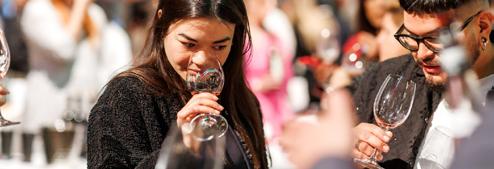









The oldest Talosa ageing cellar is located in the historic centre of Montepulciano, in the basement of sixteenth-century Palazzo Tarugi and Palazzo Sinatti. Here, where the galleries wind through a myriad of vaults and niches, visitors can admire the large oak barrels which allow Vino Nobile di Montepulciano to mature and refine. But that’s not all: going down 15 metres underground by means of a staircase located directly in the wine cellar, you arrive in the brand new tasting room. It is here, in this former air-raid shelter, that an exciting all-round wine experience ends.
Located on the hills of Montepulciano, between the Valdichiana and the Val d’Orcia: this is where the story of the Fattoria della Talosa began in 1973. The Jacorossi family winery has evolved and grown, made innovations in the vineyard and renovated structures and environments, becoming, today, capable of creating a wine proposal of great elegance and which has the scents of the soil on which the grapes grow. «We have made numerous investments to bring Talosa to the top of Italian oenology - explains CEO Edoardo Mottini Jacorossi - We have worked to give a new face to the company, always keeping our objectives very clear: high quality wines and an experiential offer that brings visitors to enjoy the immense beauty of our territory.» Today the grapes of the Fattoria della Talosa run along 33 hectares
11 employees
33 hectares of vineyards
1,5 million Euros in turnover
100,000 bottles produced Markets: Italy 64% - Abroad 36%
Management: Organic in conversion from2021
of one of the most suggestive areas of the Montepulciano vineyards. The painstaking care in cultivation and in the harvest selection of the individual parcels is synonymous with the quality of the grapes, a factor that allows Talosa to develop a high-level wine production that faithfully reflects the territory of origin. The results are wines of good structure and typicality characterised by marked presence on the nose of black cherry and violets combined with good acidity. The iconic label of the winery is Vino Nobile di Montepulciano Riserva which comes from the more clayey soils of Talosa, from over 50-year-old vines that give this product extreme elegance and territoriality. The most fertile portions of the Filai Lunghi, Alboreto, La Costa and Sotto Casa vineyards are used for the production of another excellence: Alboreto, Vino Nobile di Montepulciano, a Sangiovese of marked versatility.
 Fattoria della Talosa – Montepulciano (SI) – via Talosa, 8 – 0578 757929 – talosa.it
Fattoria della Talosa – Montepulciano (SI) – via Talosa, 8 – 0578 757929 – talosa.it
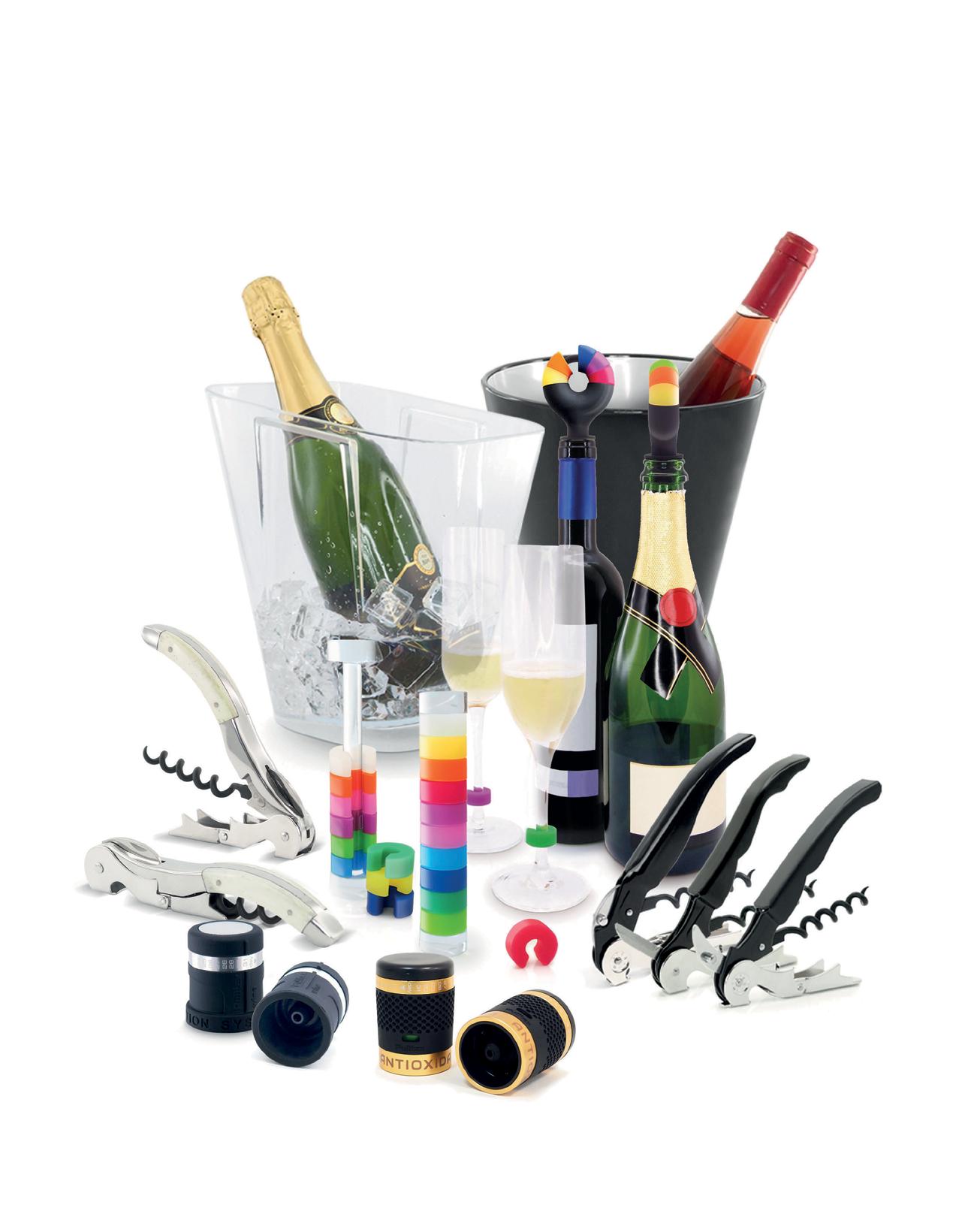


Only a two-hour flight separates Ho Chi Minh from Singapore, nothing if you think of the immense Asian continent. Still, the differences between cities are staggering. On the one hand there is Vietnam, a nation with a GDP of 8%, among the highest economies in the entire ASEAN area and therefore considered one of the countries in which to invest, also and above all in the wine and food business. On the other hand, there is a very rich city where everything runs smoothly. Clean, efficient, impeccable in every aspect and with wine super present in the many restaurants, hotels, wine bars or local wine bars.
VIETNAM. Second consecutive year for Gambero Rosso in old Saigon, the occasion is the Top Italian Wine Roadshow which takes wineries around the world eager to discover emerging markets or realities that are more difficult to reach than the more classic legs of the tour. In the hall of the historic Rex hotel more than 50 wineries presented their wines. “The requests are increasingly precise, this denotes knowledge and awareness”, explains Angela Velenosi, owner of the homonymous company.
“The reds are the most popular, especially the more structured ones. I come back here with great pleasure, I love the idea of tackling markets that are growing at a dizzying pace.” This is echoed by Davide Marino, export manager of Tenuta Mara. “Romagna exists,” he tells us, thinking about what is happening in his region, between floods and displaced residents, “but we need to go ahead and be present in different countries of the world. Vietnam is a large market, so it makes sense to invest in it.” Reds, but also whites, without forgetting bubbles that are increasingly appreciated in Asia. The day began with a masterclass dedicated to Prosecco and organised with the consortium of the Doc (moreover Prosecco was present in the tasting room with a dedicated counter and in the presence of 6 representative wineries). Lorenzo Ruggeri and Giuseppe Carrus led the tasting, strengthened by the invaluable help of Dennis Tran, a well-known sommelier and wine expert in the area: “Until a few years ago, only the great Italian denominations were known in these parts such as Barolo, little else, now we are talking about native grapes, little-known denominations, sub-areas or geographical mentions. In short, Italian wine is increasing-
ly drunk and known thanks also to what Gambero Rosso does every year in Asia.” Words confirmed by numbers. The wine market in Vietnam grows annually by 35% and Italian wine is the absolute protagonist of imports. Of the 43 million euros of wine imported, about a quarter is Italian.
SINGAPORE. The Asian city-state for three days turned into a city of wine. VinExpo took place from 23 to 25 May and Gambero Rosso organised many initiatives within the event. First of all the tasting of the 12 Special Prizes of the Vini d’Italia Guide: in the sold out venue for the masterclass led by Giuseppe Carrus in the presence of journalists and importers from many neighbouring countries. The day after was the great tasting of the Tre Bicchieri: more than 800 people were present to taste over 120 wines, brought by more than 40 wineries from all over Italy. Massimo Furlan, export manager of the Le Monde company has no doubts: “The public here is made up of true professionals, all the meetings held are fruitful and open to different perspectives. Organising the event within the fair is a winning move.”
Not just wine in Singapore. Extra virgin olive oil from Puglia was one of the stars in the city during the three days dedicated to VinExpo. Firstly with a Puglia counter within the Tre Bicchieri tasting, offering a taste of five extra virgin olive oils and focus on Coratina, the cultivar with the most polyphenols and antioxidants in Italy. Then with a masterclass on Puglia olive oil and with two appointments in the Buona Terra restaurant, where chef Dennis Lucchi also proposed dishes paired with different olive oils and made with native Puglia extra virgin olive oils. The whole project was made possible thanks to Radici Virtuose, initiatives that unite three wine consortia and the Olio di Puglia consortium, in order to promote and communicate Puglia’s gastronomic excellence.
wine is once again the protagonist

Once again this year Gambero Rosso Top Italian Restaurants guide arrives in Ho Chi Minh and Singapore and rewards the great establishments of Italian cuisine, pizzerias and wine bars.
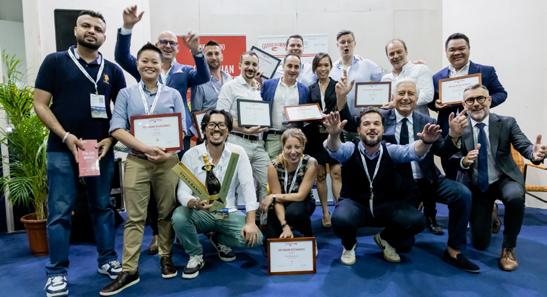



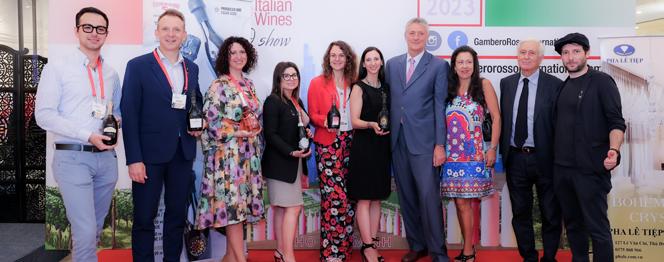

The Villa Sandi Award for the Best Contemporary Wine List came to Vietnam and was awarded to Da Vittorio – Saigon for a well-curated and well-articulated wine list, with a brilliant selection offered by the glass, unique in the city. In Singapore the prize went to Cicheti, a pizzeria with an interesting, modern, lively and fun wine list, with original and non-obvious choices.
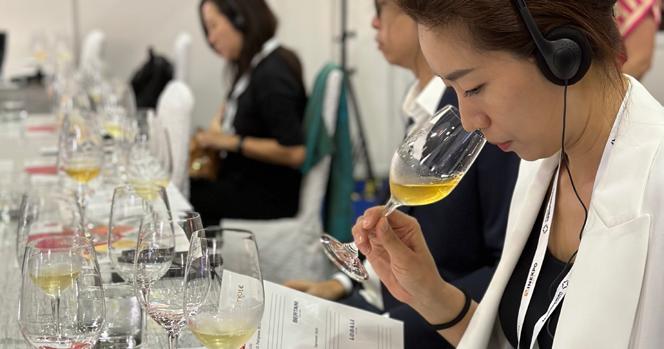
There is a glaring hole in the delivery chain: it concerns food safety and the cleanliness of the containers where food is placed during transport. The regulations are there and strict too, but unfortunately companies do not actually comply with them. As the analyses we publish below demonstrate
 by Maurizio Gaddi – photo by Yunus Boiocchi
by Maurizio Gaddi – photo by Yunus Boiocchi

ho would eat food knowing that it was transported in a container housing more than 200 colonies of bacteria?» This is the question that arises naturally at the end of the interview conducted with Laura Panzironi, head of the SiLa Laboratory specialising in food microbiological analysis, who examined one of the bags (the apparently less dirty one) used for food transport by Glovo , a leading food delivery company. More than 200 colonies of bacteria were found on the bottom and side walls of the container. To get an idea of how dirty it was - even though it looked and smelled clean - suffice it to say that it was three times as dirty as the number of colonies that can be found on the floor of a restaurant rejected for being too dirty during a health check.

The expansion of the sector has led to the development of ever stricter rules in the agri-food industry, starting from the field or cattle breeding and ending with the sale to the consumer. European food safety legislation provides for product or production rules and preventive regulations concerning the manner of business and its organisation. On the former type of rules, large food delivery companies have limited responsibility (they can, for example, exclude a particular restaurant from the app if they receive numerous negative reports) while they are directly liable for the latter.
In the area of food risk management, especially in the sphere of food safety, the prevention of food-related health risks is achieved through systematic management under European regulations, in particular Regulation (EC) No 178/2002 and Regulation (EC) No 852/2004. The system used to ensure safety is the Hazard-Analysis and Critical Control Points (HACCP) devised in the 1960s by NASA to ensure the microbiological safety of food supplied to astronauts. It is a hygiene self-control tool "designed to help food business operators achieve a higher level of food safety." Responsibility for food hygiene is assigned to food business operators throughout the food chain, including transport operators, by Article 2 of Regulation (EC) No 852/2004.
Having this information available, probably few would eat the dish they ordered. Even if the food arrives in the packaging provided by the restaurant, the risk of contamination is still very high : all it takes is the packaging that contains the food order not being tightly sealed for this to happen, not to mention the cases where the food may come into direct contact with the bag that transports it (as with pizzas, whose cartons are placed directly at the bottom of the carrier bag).
To prevent the transport of food from becoming dangerous for the consumer , the law requires that all operators take measures to ensure food hygiene and safety . Operators must undergo specific training on the subject, as they do in restaurants and throughout the food production chain. However, this is not happen -

ing: taking advantage of the anomalous lack of controls by the competent authorities, food delivery companies are particularly weak in training their staff, as would be required by national and European regulations. The only ones who pay the consequences are the end consumers, who cannot be sure that they are receiving a product that has been transported properly , i.e. free from any risk of contamination.

Committente: GAMBERO ROSSO SPA, Via Ottavio Gasparri, 13/17 - 00151 Roma
RdP: Certif. n. 1452/2023
alle ore: 12,30
Provenienza:
Campione ricevuto il: 06/06/2023
alle ore: 12,30
Fine analisi: 09/06/2023
Campionamento eseguito da: Tecnico SI.LA. S.R.L. il: 06/06/2023
Inizio analisi: 06/06/2023
Descrizione campione: TAMPONE STICK
Etichettatura campione: BOX DI TRASPORTO TERMICO PER ALIMENTI
Analisi effettuata c/o altro Laboratorio: si o no
Roma, 09/06/2023
Legislation requires that all employees must be supervised and receive training and instruction in food hygiene. Compulsory training varies from region to region, but generally consists of training courses of several hours , which can only be avoided in the case of proven prior experience. However, by simulating all the stages a rider has to go through when joining
Superficie campionata: 100 cmq
Temperatura di trasporto: --
PARAMETRI
RAPPORTO DI PROVA
Metodo di Campionamento: ISO 18593:2018
ANALISI MICROBIOLOGICA SUPERFICI ED ATTREZZATURE
D.Lgs. 193/2007
del campione: Idoena
INCERTEZZA DI MISURA (inc. estesa)
U.M.
(*) Prova non accreditata da ACCREDIA L’incertezza di misura viene calcolata con un livello di probabilità del 95% e con un fattore di copertura
EN ISO 21528-2:2017
Carica Microbica Totale (Buone pratiche di esecuzione del campione Ed. 2004 - Servizio Sanitario Regionale Emilia Romagna ):

<5 : OTTIMO
: BUONO
: SUFFICIENTE
: NON ADEGUATO
: INACCETTABILE Staphylococcus aureus, Salmonella, Listeria monocytogenes: Assenti
LIMITI ( UFC/cmq) : GIUDIZIO: Il campione sottoposto a prova non risulta conforme ai limiti per i parametri analizzati.
JUDGEMENT: The sample tested does not comply with the limits for the parameters analysed.
GIUDIZIO: Il campione sottoposto a prova non risulta conforme ai limiti per i parametri analizzati.
Certificato di analisi valido a tutti gli effetti di Legge come previsto dalla Legge n. 679 del 19.07.1957 e successive modifiche ed integrazioni (Legge del 20.03.1975 n. 56 - D.M. 21.06.1978 - D.M. del 25.03.1986). Il presente Rapporto di Prova si riferisce esclusivamente al campione oggetto di analisi. I risultati si riferiscono campione così come pervenuto. La riproduzione parziale o totale del presente Rapporto di Prova deve essere autorizzata per iscritto dal Laboratorio SI.LA. s.r.l. giudizio non è oggetto di accrediamento. Se non già indicate nel Rapporto di Prova sono disponibili su richiesta i dati di incertezza di misura delle singole prove accreditate. I risultati si riferiscono al campione così come pervenuto. Il laboratorio è responsabile di tutte le informazioni riportate nel presente Rapporto di Prova, ad eccezione delle informazioni fornite dal Committente. Il laboratorio SI.LA. srl e’ iscritto nell’elenco della Regione Lazio dei laboratori che effettuano analisi ai fini dell’autocontrollo per le industrie alimentari del D.G.R. n.366 del 2 settembre 2011, con determinazione n. B01179.

Secondo il referto del laboratorio Si.La. di Roma, il campione estratto dal box risulta non adeguato per la sua carica microbica totale misurata a 30°: dovrebbe essere inferiore a 5 per un risultato ottimo, tra 5 e 25 per un risultato buono e tra 25 e 100 per un risultato accettabile. Qui leggiamo una misura di 286 UFC/cm2: quasi il triplo del limite. Inoltre, nel campione sono presenti enterobatteriacee
Certificato di analisi valido a tutti gli effetti di Legge come previsto dalla Legge n. 679 del 19.07.1957 e successive n. 56 - D.M. 21.06.1978 - D.M. del 25.03.1986). Il presente Rapporto di Prova si riferisce esclusivamente al campione campione così come pervenuto. La riproduzione parziale o totale del presente Rapporto di Prova deve essere autorizzata giudizio non è oggetto di accrediamento. Se non già indicate nel Rapporto di Prova sono disponibili su richiesta accreditate. I risultati si riferiscono al campione così come pervenuto. Il laboratorio è responsabile di tutte le informazioni ad eccezione delle informazioni fornite dal Committente. Il laboratorio SI.LA. srl e’ iscritto nell’elenco della Regione Lazio dei laboratori che effettuano analisi ai fini del D.G.R. n.366 del 2 settembre 2011, con determinazione n. B01179.
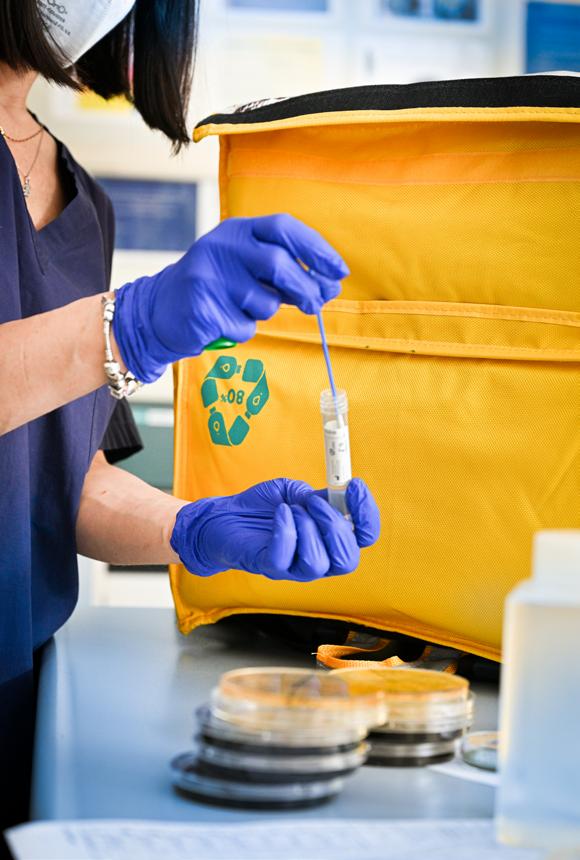
The control of compliance with food safety regulations is entrusted to ASL (Azienda Sanitaria Locale – Local Health Unit, i.e. centre of administrative operations related to Public Healthcare in Italy under the National Healthcare Service, specifically the veterinary and food hygiene Services branch), NAS (the Anti-Adulteration Unit of the Carabinieri) and Icqrf (the Central Inspectorate for Fraud Repression). This is at least on paper, because the reality is quite different: no one systematically checks food hygiene during transport. A major issue is the state of preservation of foodstuffs: according to HACCP procedures, cooked perishable foodstuffs to be consumed hot must be transported between 60°C and 65°C, while perishable foodstuffs to be consumed cold must be stored at a temperature not greater than 10°C. Furthermore, to respect the cold chain, food should be transported in vehicles equipped with commercially available ATP (Accord Transport Perissable) containers, although due to their size they can be transported by motorbikes or trucks, but not by scooters or bicycles. Here some conflict arises between sustainability and safety: on the one hand, companies emphasise that they are green through the use of bicycles, on the other hand, these are not suitable for supporting the most suitable tools to comply with safety protocols such as maintaining the cold chain intact. A similar argument can be made with cardboard containers, which are more sustainable but at the same time more prone to contamination because they are less airtight.

Glovo before being able to receive his first order, we found that the company turns these complex training courses into a small, superficial compendium, consisting of a series of vague and imprecise slides on food safety and a short video on the steps to take when cleaning containers. Before the pandemic, the situation was not so much better: there was a single collective interview, which took place in groups of 40 people and lasted about an hour, in which the rider had to deal with all work-related issues, including hurriedly covering food safety.
One of Glovo's mottos is: « Everything your city has to offer. Delivered in minutes. » This is what makes the Spanish company's service different from its competitors: while other players in the sector only deliver

“A long story to discover sip by sip.”
food, Glovo allows you to buy or transport anything from cosmetics and flowers to medicines and sex toys. A factor that exponentially increases the danger of contamination. The European regulation states that "if vehicles and/or containers are used to transport goods other than foodstuffs or different types of foodstuffs, they must be thoroughly cleaned between loads to avoid the risk of contamination. » But how can a tired and underpaid rider be expected to give up making an extra delivery during his shift in order to carry out this thorough cleaning, which, moreover, is very delicate and takes time to perform correctly? Moreover, in the section on food safety provisions in the contract with its riders, Glovo makes no reference to this.

« It is recommended to keep the containers clean at all times; daily cleaning of the bag
with soap and disinfectant is recommended (the process should include cleaning with soap, wiping, disinfecting and rinsing, wiping again with paper and finally drying)". These are - together with the course to be taken on the platform - the instructions in the contract regarding the cleaning of delivery bags. On the contrary, during the training courses on the HACCP system, staff are instructed in detail on the procedures: in particular, sanitising and disinfection of the transport container must take place with one of the specific products approved by the Ministry of Health and listed on the official website. In addition to the burden of keeping the bags clean, the companies also charge riders for the purchase of said sanitising products . We asked the companies for a comment. It was Fabrizio Francioni, senior communications manager of Deliveroo Italia, who informed us of the official position of AssoDelivery,

One of the possible solutions to ensure a lower risk level for foodstuffs could be the reversal of the mechanism that entails entrusting the container to the rider. By creating centres that disinfect and sanitise the containers through specialised personnel, safety standards would be much better met: the rider could pick up a sanitised container at the beginning of his shift and hand it over at the end, after having used it. In this way, he/she would not have to take care of its cleaning and the consumer would be guaranteed compliance with the HACCP procedure. Such a solution would entail a greater expense for food delivery companies, with a cost that they do not currently face (such as renting a venue, hiring specialised personnel for cleaning and purchasing the products for sanitising and disinfecting the container).
the Italian association of the food delivery industry to which Deliveroo, FoodToGo, Glovo, SocialFood and Uber Eats belong:

« Riders who work as independent contractors with the platforms adhering to AssoDelivery take compulsory courses on road safety and food hygiene and transport.
The food hygiene course aims to provide information on the laws with reference to the 'Hygiene Package', with a focus on the management and maintenance of hygiene conditions during food transport and delivery.
The food safety course also complies with the requirements of HACCP regulation » According to the prevention paradigm, the company's objective should be to ensure food safety at the highest level, but this type of management is totally inadequate, even if economically more profitable for the company.

However, choosing the most cost-effective route carries a very high ethical price : the company entrusts a delicate task such as the cleaning of a food transport box to staff who are not adequately supported on this issue.
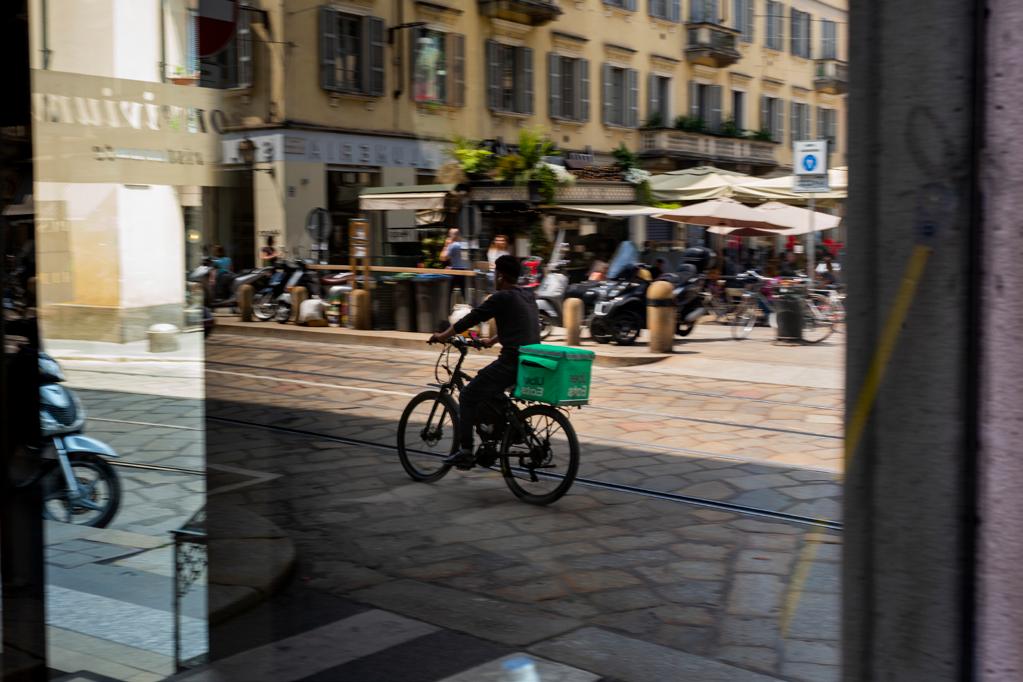

The negative consequences of this choice fall on those who use their service: people who order a dish expect the same safety standard to be met as they are used to finding when ordering it in a restaurant, but without precise training of the staff and without controls by the authorities, the risk of unknowingly eating contaminated food is very high. As the analyses on the boxes we wanted to test in the laboratory show.
According to attorney Adriana Coltrioli , the contract is imprecise in its provisions on food safety: «The agreement includes a series of tasks identified generically ("it is recommended to keep the containers clean at all times") and subjectively interpretable,» explains Coltrioli. «The company's attitude becomes even more serious in view of the regulations on transport, which require a certain level of cleanliness and hygiene and certain ways of storing goods.» In an area that requires care and precision, Glovo's contract does not impose precise rules: «The company does not technically identify what must be done while imposing the burden on the worker; on the other hand, it does not assume any burden of control and revision on the execution of the provisions. Consequently, an unspecified obligation arises, because no minimum standards of hygiene are set below which a breach of contractual provisions could occur.»
Vinicola Palamà is the story of a family that has based unbelievable sacrifice, dedication and vision on the motto “the love for the soil becomes wine.”

The winery was officially born in 1936 when Ester Palamà worked in buying and selling wine, an activity that continued until the 1950s. It was then that her brother Arcangelo began producing and bottling, creating the cellar that today is still the heart of a company that has expanded and evolved, without ever losing sight of its origins.
“My grandfather - says Michele Palamà - sold wine in small 70-litre barrels from which the wine was tapped and sold in osterias. In 1986 my father Ninì, just twenty years old,

took over the business and from small casks he moved on to 5-litre demijohns in large-scale distribution, up to the HoReCa sector, now exclusively.”
The third generation of the Palamà family, embodied by Michele, is the daily spokesperson for a tradition that makes use of innovation to continue the story of its production.
“Since 2018 I have been running the company - continues Michele - I was 25 years old and had great desire to experiment. My father, who was 55 years old at the time, supported my desire to make changes, aware that his experience would always guide the path of our Vinicola.”

Palamà wines are declined in the strong Puglia language, but the na-
tional and international gaze is felt at every sip. “For me, innovation is not a stylistic concept - explains Michele - but an ethical and sustainable idea. It means making the production quality excellent without ever distorting the past from which everything started.”
Among the most recent innovations is the development of an app that allows you to scan the QR codes of each individual tank and receive all the related data, from whoever cleaned it to the progress of the fermentation. Small details that contribute to optimising an entire process that has the goal of making an increasingly valuable wine.
Among these, Metiusco stands out for its fresh and by now iconic line.
The label celebrated its twenty-fifth year in 2021 and has been awarded in all the most well-known national and international competitions. The name translates to “I get drunk” and is inspired by the anecdotes Michele’s grandmother had about farmers who found work in the vineyard and then went drinking to celebrate their happiness. It is a wine that has always kept the grapes, its style and its characteristics intact, always remaining true to itself and becoming a true symbol of the cellar.

The pride of the Metiusco line has written an important page in the winery’s history with its white, red and rosé wines. Metiusco Anniversario celebrates with its birth the 25 years of the homonymous line, enhancing the hints of Mediterranean maquis and herbaceous notes, the body structured by tannins and the bitterish finish typical of the vine. «Negroamaro is a phenomenal grape, with many interpretations, some sensational, but I had difficulty finding an authentic one and I wanted to make one that fully represented the grape.»
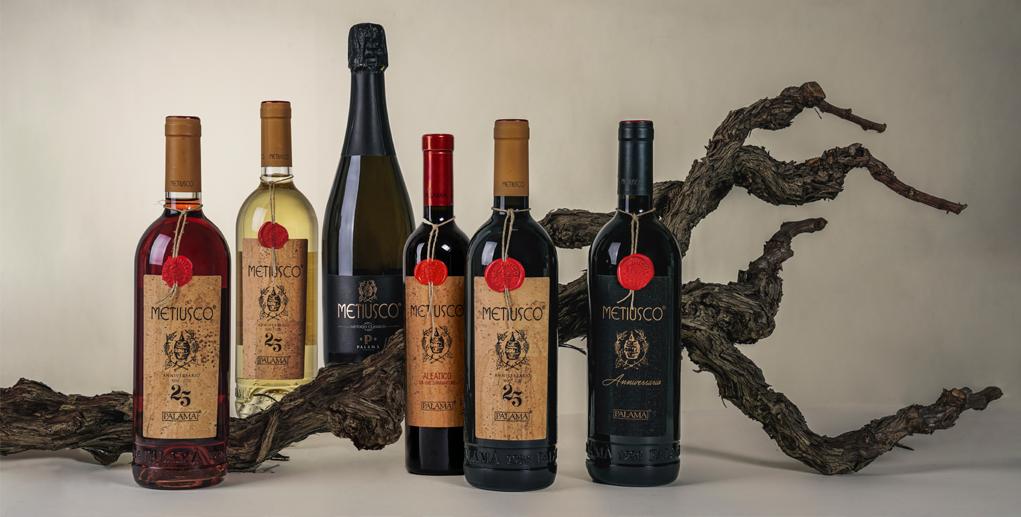
Vinicola Palamà – Cutrofiano (LE) – via Armando Diaz, 6 0836 542865 – vinicolapalama.it

THE (NON) FASHION OF ALCOHOL-FREE DRINKING
The market for 'alternative' beverages is growing
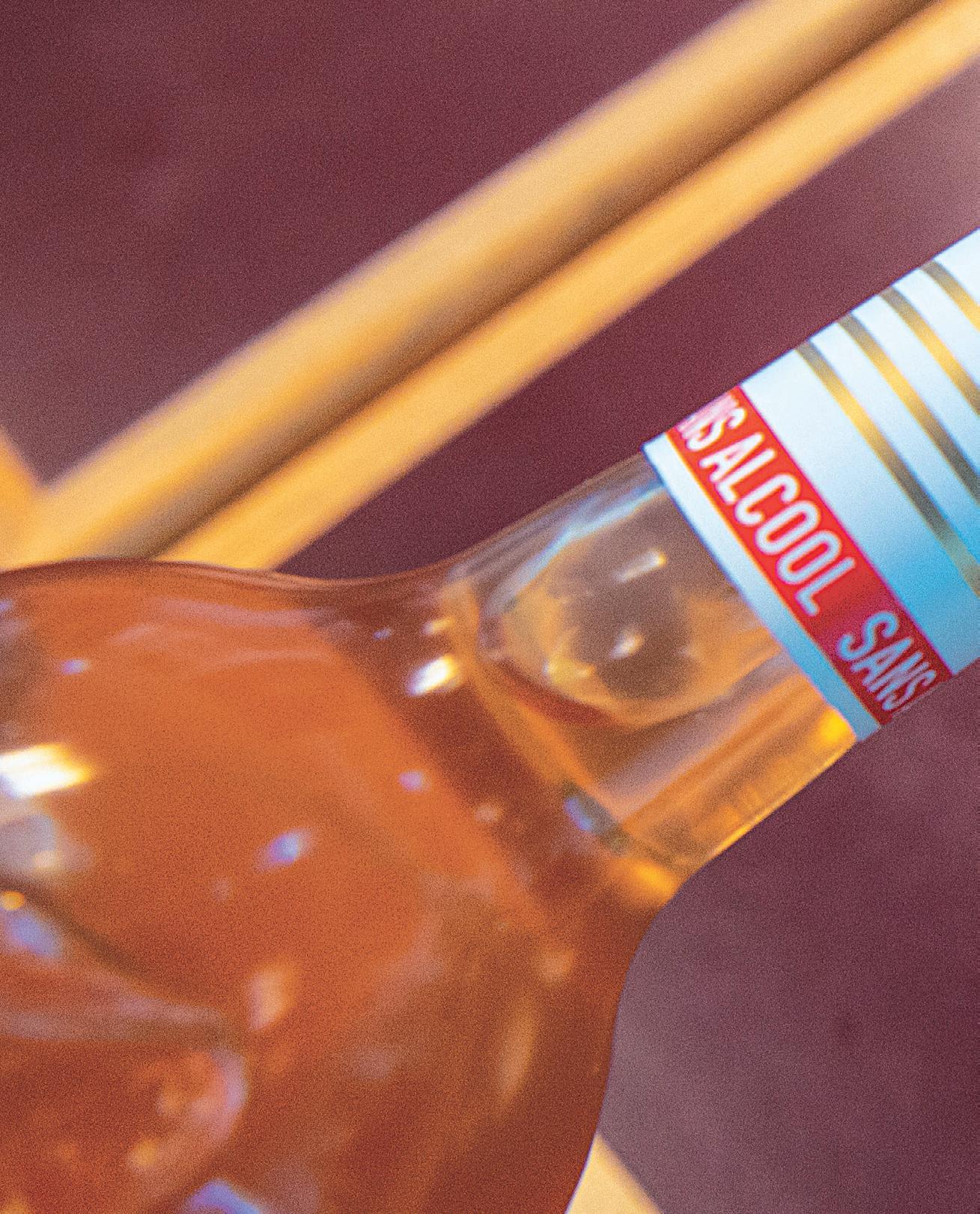
The market is growing, even if the trend of alcohol-free wines is not yet taking off here. There are also some made in Italy, but only from unfermented must: de-alcoholisation is forbidden here. And in any case it can't be called wine
 by William Pregentelli - photos by Fabrizio Perilli
by William Pregentelli - photos by Fabrizio Perilli
From one extreme to the other. If on the one hand the defenders of the atavistic essence of wine (the so-called natural wines) and its visceral relationship with the territory, with the soil and with the people who produce it (and who drink it) line up, on the other, when we speak of non-alcoholic wine, we instead enter the territory of the extreme technologisation of a production process that almost distorts the starting key ingredient, the grape. So much so that, once the alcohol has been removed, the product we have, by law, can no longer even be called wine: it becomes a simple beverage, a sort of "soft drink" closed in a container that mimics those of Bacchus nectar. As if the very essence were removed from the wine. And yet, as the numbers tell us, there is a market demand: a heterogeneous and growing market
Suffice it to say that one of the most important world wine fairs, Prowein in Dusseldorf, in the last edition hosted a space in one of its pavilions, the World of Zero, dedicated exclusively to non-alcoholic or low-alcohol wines. The phenomenon therefore cannot be underestimated.
But let's take a step back. The first question that comes to mind is: how do you produce a non-wine wine? There are basically two ways. The first, the simplest - which is also the only one allowed in Italy - consists in the simple transformation of a non-fermented grape must: technically, this product never becomes real wine, it does not ferment. As Daniela Sorana of Colonnara, a winery in the Marche region of Cupramontana, in Castelli di Jesi also explains: «Our Icemary (see tasting notes
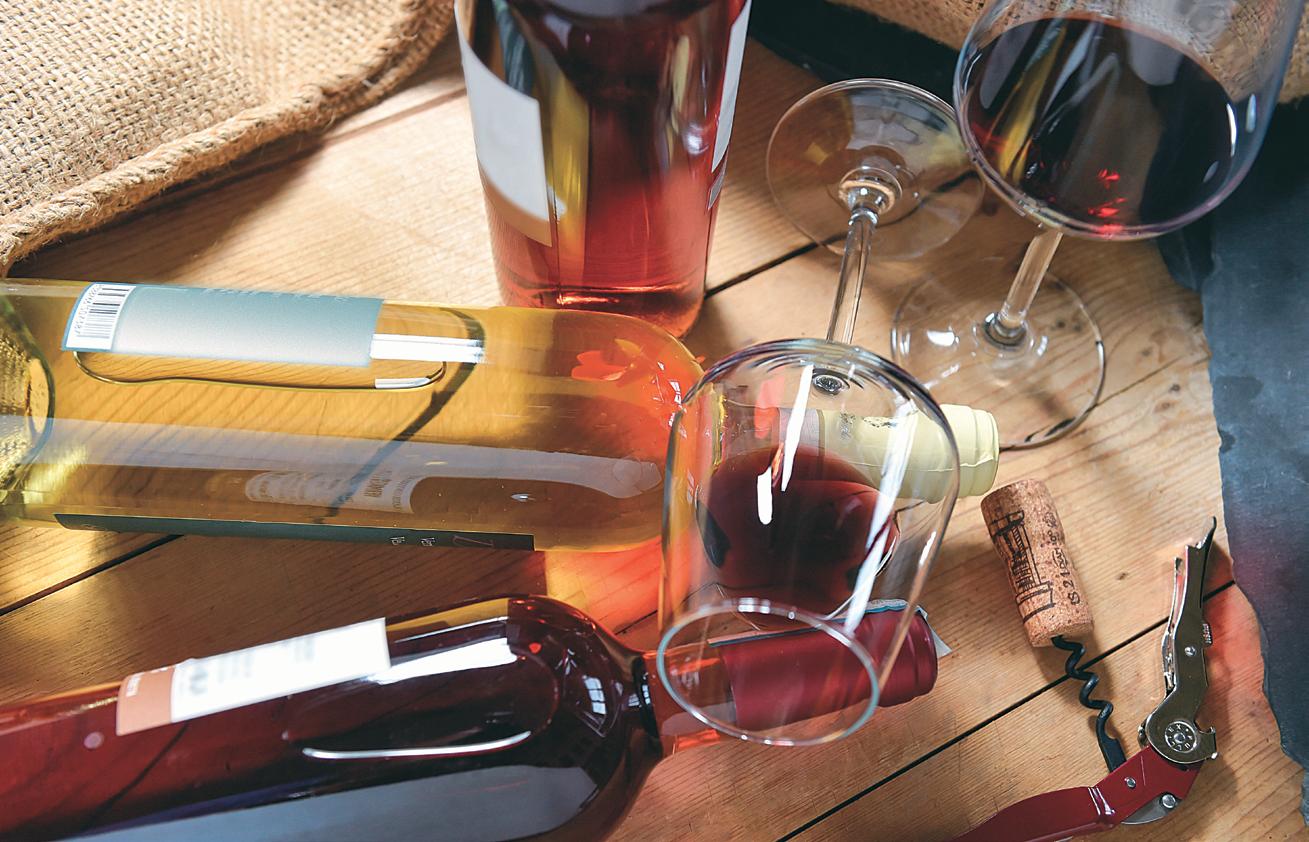
below, Ed.) is a micro-filtered grape juice to which fermentation is blocked and food grade carbon dioxide is added to create the bubbles.»
The other way is quite more complex and requires more sophisticated equipment: the process is called de-alcoholisation and, as can be deduced, it is a procedure that removes alcohol from a finished wine. Here the paths fork further because different techniques can be adopted to remove ethanol molecules from the wine. The two that are most popular are osmosis (using a particular membrane and water) and vacuum distillation. The latter would seem to be the most widely used solution: «But it can't be done in Italy, the law doesn't allow it for now - explains Daniele Simoni , CEO of Schenk Italyn Wineries, a wine group with companies in various Italyn regions - We, for example, make it at our sister company in Spain, Bodegas Morviedro. We produce around 200,000 bottles a year and we sell it mostly on Eastern European markets.» What about in Italy? «There is no interest; three years ago we tried to sell a "Spritz Zero Alcohol" but after a promising start we didn't see the consumer response we hoped for.»
Whatever the proclamations and warnings of the scientific community, we are still too used to real wine: «From a research carried out by our holding, the consumers of these products are not ordinary wine drinkers. It is rather an audience of curious people who want to try something different. Unlike beer, where the industry has managed to obtain a de-alcoholised product with a taste very similar to the original, the limit of dealcoholised wine is that, if no flavourings are added, it ends up not resembling the original product.»
To proceed with de-alcoholisation it is very important that the starting wine does not have any defects, it must be very good quality, very clean: any ripple, aromatic or gustatory, will be exponentially amplified in the process. Furthermore, it must be almost completely dry, with no residual sugar: in short, it must be a rather neutral base. The process we use in the Spanish factory uses a machine called "spinning cone column". It is practically a de-alcoholisation that takes place through the evaporation of the alcohol in a vacuum-packed container. To carry out the process, the temperature inside this column must be raised. The boiling and evaporation point of water is 100°C; alcohol evaporates at 78°C. But obviously we don't push the temperatures to this level, otherwise all the other organoleptic characteristics of the wine would also be lost. This is where the importance of carrying out the vacuum process comes into play: it allows us to work between 20°C and 30°C. If you create a vacuum inside the container, the evaporation inside the column starts earlier. After the de-alcoholisation process, the product must necessarily undergo small adjustments. Sugars are completely absent and the product is difficult to drink; you have to add a little, without exaggerating of course. To make an effervescent, sparkling wine, Co2 is also added.
– Daniele Ress , Technical Director Schenk ItalyThe technique involves the use of hydrophobic membranes, i.e. not permeable to liquids, which only let gaseous molecules through. On the sides of this membrane, on one side passes wine, on the other water. Alcohol, by gradient difference, passes from the liquid where there is more (wine) to the one where there is less (water). The process is faster the greater the difference in alcohol concentration in the two liquids. As a matter of fact, as the water "takes" alcohol, the passage through the membrane slows down. It is a technology that operates at room temperature and pressure and for this reason, compared to other more invasive techniques, it has no impact on the wine. The final product that is obtained must be managed on the basis of the pre-established objective. In this sense we are working on the development of protocols that see the addition of natural substances to rebalance the organoleptic profile of the wine: yeast derivatives, mannoproteins, gum, tannins. Our most important customers in this area are located in South America. This method is quite innovative; we are sure that it will be the main method of de-alcoholisation in the near future, when there will be precise legislation. My idea is that there will be a boom not so much in de-alcoholised wines, rather in partially dealcoholised wines with 5-8% alcohol.
– Albano Vason , General Director Enologica Vason

At first it was sans added sulphites, then one without selected yeasts and additives. Finally, the one without alcohol. In the decade in which subtracting is better than adding, wine is no exception. But are we talking about a contradiction in terms? Not necessarily. Before turning up our noses, let's try to understand the terms of the question, starting from an irrefutable truth: 50% of the adult population in the world does not consume alcoholic beverages. Whether the reasons are religious, health or even taste, the result does not change: there is a whole target to conquer that defining strategy would be an understatement. But not the only one.
It is a fact that in the main alcoholic beverage consuming countries a low alcohol trend is increasingly establishing itself. The Unione Italyna Vini Observatory notes that according to the World Bank, per capita alcohol consumption is decreasing, without "free zones": –3.2% in Italy, –1.8% in the UK, –1.4% % in France and the Netherlands, –1% in Germany. Can alcohol-free wine takeor take back - a consumer who is not exactly alcohol addicted? And this is where the forecasts of the Iwsr Drinks Market Analysis institute come into play according to which, in 10 key markets, the no-low alcohol category of wines will
by LoredanaSottile mark an average annual growth of 8% in volume (2021-2025). In particular, an increase of over 20% (2021-2025) and a doubling of volumes by 2025 is expected for no-low alcohol still wine. The protagonists of these new trends will be young people between the ages of 20 and 30. Precisely that generation that the world of traditional wine has difficulty attracting.
«We are talking about a totally different target that would not compete with wine,» underlines Daniele Simoni, CEO of Schenk group which has been producing de-alcoholised drinks in Spain for years. "Rather, we would intercept a consumption that is currently in the hands of the beverage and soft drink sector." In short, if the wine world isn't doing it - starting from grapes - certainly the multinationals of beverages will not stand by and watch.
On the side of wine producers, the desire to discover this new face of production is not lacking. We saw it this year at ProWein. The German trade fair polled the opinions on future intentions of more than 2,500 manufacturers, traders and distributors from nearly 50 countries. The response leaves no doubt: almost half of wine producers and merchants intend to adapt their wine portfolio to market trends and there is 27% who are already investing in no- and low-alcohol.
Another survey also conducted by Messe in Düsseldorf which involved wine retailers in 16 areas, drew a map of the markets most interested in the trend: United Kingdom in the lead (53%), followed by the Netherlands (43%), Finland (36 %), Germany (34%) and Norway (33%). The choice of the United Kingdom as a key
If non-alcoholic wine is still almost taboo in Italy, the same cannot be said of beer and cocktails (aka mocktails), which have somehow paved the way (see monthly Gambero Rosso July 2021 issue n. 354 and January 2023 n. 372).
Among the latest arrivals in this category, there is also one of the main Italyn cocktails: Bellini, produced in the non-alcoholic version by Casa Vinicola Canella. The novelty compared to other mocktails that replace alcohol with other beverages is that the recipe remains identical: three parts of Brut sparkling wine, one part of white peach juice and pulp, and a few drops of raspberry. But, in this case, the alcoholic part of Prosecco is extracted with a process capable of maintaining all the aromatic components.
50% of the population
market also affects a strictly economic reason: the British tax system applies very low tariffs or even no tariffs on products with low alcohol content. And this could be a further strong point for this type of product.
Looking at the types of wine, whites (73%) and sparkling wines (58%) lead the no-low alcohol category, ahead of rosés (37%) and, finally, red wines (27%). In this choice, there is also a technical reason: dealcoholising whites is simpler than doing it to reds, for which the industry has to work above all on the excess of tannins.
The possibility of producing alcohol-free wines in Europe was introduced for the first time by the CAP 2023-2027, approved in October 2021, finding a compromise: the green light for the total dealcoholization of table wines (alcoholic strength below 0.5%); partial dealcoholisation for Dop and Igp (alcoholic strength higher than 0.5%).
To do this, the subtraction of alcohol is practised using technologies ranging from evaporation to the use of membrane systems. Until then, reference had been made to individual national legislations. So if for Spain and Germany it was already a practice used for some time, for Italy it was off limits, since, according to our legislation, to be called wine, a product must have an alcohol content of about 8 degrees (each appellation, furthermore, refers to its specific regulation).

The new CAP has therefore paved the way. But that's not enough. In Italy, despite the OK given from Europe, there is still an insurmountable obstacle to the practice: the Testo Unico del Vino, which hands out hefty fines for those who keep wine with an alcoholic strength of less than 8% in
the cellar. There should therefore be action taken in the legislative sphere, but it is not so obvious, considering that the Minister of Agricultural Policies Francesco Lollobrigida has repeatedly taken a stand against alcohol-free wines: "They are not be called wine," he also reiterated in a recent interview with the weekly Tre Bicchieri.
Yet, at this moment it could represent a solution to the problem of overproduction and stocks in the cellar, as some politicians recall, between parliamentary questions already filed and others on the way. One is put forth by Movimento 5 Stelle, with the first signatory Alessandro Caramielo denouncing how there is a stalemate, while «associations, producers and wineries are asking to intervene on the Consolidated Wine Text,» especially in the light of «the current snapshot of the national wine production which presents a
country where stocks of wine are growing; with the production of de-alcoholised or partially de-alcoholised wines also opening up an alternative market outlet.»
The secretary general of the Unione Italyna Vini Paolo Castelletti pushes stronger: «This regulatory vacuum is in fact causing Italy to lag behind European producers by about a year in competition. To date, Italyn wineries that want to start the production of alcohol-free wines within their own plants do not have indications from the administration because, unique in Europe, we are not yet aligned with the provisions of the European Union, which came into force 15 months ago. The path we suggest - also given the pressing request from businesses - is harmonising the Italyn device with EU dictates through a Government amendment to the Text that can be approved by Parliament in a short time.»


And now, the tastings. First consideration: those accustomed to drinking wine will hardly be comfortable with these products in the glass. It is incredible how the organoleptic aspect is completely distorted in the absence of alcohol. It's really a question of character: the aromas are more flat, the sip has less bite, the flavours are flabby. Second consideration: it is hard to understand how these products can be paired to food. They could work for an aperitif or for a carefree sip, but we are sure that on the table, any table, even the most exotic one, these alcohol-free wines cannot work precisely because of their "limpness." Since they are beverages, the back labels of these products carry the list of ingredients. In addition to de-alcoholised wine, carbon dioxide, water, natural flavourings, sugar, fruit juices (especially apple and pear) often appear: all illegal ingredients in the production of wine. Often present are also rectified concentrated must, potassium metabisulphite, gum arabic, tannins, stabilisers, citric acid, tartaric acid, malic acid, mannoproteins: substances which are instead allowed in the winemaking process, but which wine producers are not obliged to to report on the label. Otherwise the poetry would be lost! Ditto for the nutritional tables: these non-alcohol products (at least the ones we've tasted) always report calories, sugars, proteins, sodium, even fats; in wine, on the other hand, nothing, despite the fact that, as everyone knows, it is a highly caloric product (precisely because of the alcohol content). Perhaps, at a time when the wine-health relationship is heavily in the spotlight, the world of wine would need a little more courage in the effort towards greater transparency and a more aware consumer.

Aldea - Tempranillo
Alcohol: 0.0%
Provenance: Spain
Grapes: tempranillo
Nice flavour profile. It tastes like blackberry, blueberry, like certain New World wines, a little eucalyptus; in the mouth it feels like grape juice; it tastes of strawberry grape, the tannin is completely uncovered and green; it is sweet and at the same time binding and astringent.

Canter - Rosso Perfetto
Alcohol: 0.0%
Provenance: Italy
Grapes: n.d.
Aromas of grape juice characterised by a glazed sensation, oxidised cherry; in the mouth it is rather bitter, the tannin is moody; the sip is empty and short; it's like water and tannin.
Castillo de SalobreñaRed
Alcohol: 0.0%
Provenance: Spain
Grapes: n.d
"You've got to be kidding" is the first thing that came to mind. Blindly, no one in their right mind would have linked the flavour profile to a wine. Notes of banana and
apple milkshake emerge (apple juice is one of the ingredients), strawberry ice cream, bitter almonds. It is sweet and the apple also comes back strongly on the palate.
Cero -
Chardonnay
Alcohol: 0.0%
Provenance: USA
Grapes: chardonnay Ripe peach; it's like one of those oaky Chardonnays that smell of toasted hazelnuts and butter. In the mouth there is a lot of peaches soaked in syrup, but it has consistency. Very soft, in the finish it recalls candied citron.
Cero - Rosé
Alcohol: 0.0%
Provenance: USA
Grapes: tempranillo
To the eye, it looks oxidised; on the nose there are sensations of lees and crushed strawberry. The palate is a bit sandy and reminiscent of wild strawberries.
Cero - Zinfandel


Alcohol: 0.0%
Provenance: USA
Grapes: zinfandel "With a delicious authentic taste" reads the label. "Maybe?" we add. Sharp, purple, superfloral rose petal, magnolia, linden, wisteria, it looks more like an aleatico than a zinfandel; in the mouth it opens sweet and bitter at the same time, it has dry tannins and a flat sip.
Colonnara - Icemary
Organic Sparkling
Alcohol: 0.0%
Provenance: Itay
Grapes: white grapes authorised in the marche region
It is not a dealcoholised wine, but rather an unfermented grape juice with added carbon dioxide to create bubbles. Probably an unlucky bottle: there are evident hints of oxidation, little aromatic precision. The mouth is also very sweet and limp.





D'Artigny - Cuvée Prestige
Alcohol: 0.0%
Provenance: Francie
Grapes: chardonnay
Pear and apple nectar, white

flowers, jasmine, icing sugar; all very clean, honest, slightly beerlike, fresh. The sweetness is calibrated just to give a little body.
DCSauvignon Blanc

Alcohol: 0.5%
Provenance: South Africa
Grapes: sauvignon Super grapefruit, then green pepper; reminiscent of a hot-zone sauvignon, lychee, peach. The controlled sweetness and acidity recalls grapefruit, it has a good length and a nice herbaceous vegetal sensation in the finish; in a battery of battle sauvignons it could be difficult to recognise...
DC - Shiraz
Alcohol: 0.5%
Provenance: Sud Africa
Grapes: shiraz
Gum, goudron, inky; contracted and bitter mouth; completely split acidity. Tastes like coal..
Kolonne NullCuvée Rouge n. 02

Alcohol: 0.3%
Provenance: Germany
Grapes: Grapes spain(?)
Note di cartoNotes of cardboard on the nose, then a little blackberry emerges. In the mouth it is very dry but the tannin is green and drying; the sip is very short, the palate is empty.

Kolonne Null - Riesling '21 Yes, there’s even a vintage!)



Alcohol: 0.3% Provenance: Germany

Grapes:riesling
Slight sage, a little lemon, dull aromas; works much better in the mouth, nice acidity and tanginess, slight sweetness but from a German riesling you can also expect that. It has the right acidity and a "wine" progression; it closes by going back to lemon. Among the best in the tasting.
Le Petit BéretCabernet Sauvignon

Alcohol: 0.0%
Provenance: France
Grapes:cabernetsauvignon Strawberry candy, pickled olives, sweet 'nduja-like pepper (the varietal!); very sweet mouth, everything that is there returns to the nose; it's like molasses.
the ingredients; the bottle has sediment in it. The contents has probably gone bad: the scents are reminiscent of rancid fat. The mouth is all dishevelled and very unpleasant indeed.
Le Petit Béret - Sauvignon

Alcohol: 0.0%
Provenance: France
Grapes: sauvignon
Le Petit BéretPremium Chardonnay

Alcohol: 0.0%
Provenance: France
Grapes: chardonnay The colour is spot on, it also has greenish reflections; the nose smells of apple juice, there is a touch of passion fruit that also returns in the mouth. The sweetness gives a little body, slight acidity on the closing. In the finish, between grapefruit and white rose, it almost tastes like a traminer.
Le Petit BéretRosé Biologique
Alcohol: 0.0%
Provenance: France
Grapes: n.d
Strangely cloudy; carrot concentrate also appears among
PrincessAlternativa 0.0 Bianco
Alcohol: 0.0%
Provenance: Italy
Grapes: nd
It smells of must but also of dried peas, fermentative notes, fruit salad. On the palate it is almost non-existent.
Very imprecise nose, musty sensation; mouth is completely disjointed, harsh; it closes bitter, almost metallic.
PrincessAlternativa 0.0 Rosato
Alcohol : 0.0%
Provenance: Italy
Grapes: nd
Oddbird - Blanc de Blancs
Alcohol: 0.0%
Provenance: France (distributed by a swedish company)
Grapes: colombard e chardonnay
Very vegetal and herbaceous, radish emerges; the mouth is vaguely acidic, but with an added citric note; disjointed, without balance, note of grains in the finish.

Very imprecise on the nose due to a bad cardboard note, slight sensation of bitter orange; even in the mouth it is vaguely citrusy, we find red fruits but the sip is limp..
PrincessAlternativa 0.0 Rosso
Alcohol: 0.0%
Provenance: Italy
Grapes: nd
Scents of grape juice but with a powdery profile; the mouth is completely contracted by the tannin. No pleasant notes.
Princess - Alternativa 0.0
Rosso Superiore
Alcohol: 0.0%
Provenance: Italy
Grapes: nd
Cherry juice, then musty linen chest; very ripe fruit, cherries in alcohol, it almost seems to have something alcoholic. Improbable tannins, slight return of fruit, but there is no breadth, no taste..
Princess - Alternativa 0.0
Sparkling Dry
Alcohol: 0.0%
Provenance: Italy
Grapes: nd
Dealcoholised wine with the addition of carbon dioxide for bubbles. Very blurry aromas; there is an evident fungal note and the sip is completely anonymous and empty.
Princess - Alternativa 0.0
Sparkling Extra Dry
Alcohol: 0.0%
Provenance: Italy
Grapes: nd
Dealcoholised wine with the addition of carbon dioxide for bubbles. Little different from the one above even if a little pear emerges here, both on the nose and in the
mouth. The problem is always the palate, almost non-existent if it weren't for a very slight sugary sweetness.
RivaniZero Alchol Sparkling
Alcohol: 0.0%
Provenance: Italy (but prouced in Spain)
Grapes: nd
Dealcoholised wine with the addition of carbon dioxide for bubbles. Zigulì drugstore lemon candies, something balsamic reminiscent of toothpaste, and then a series of effervescent medicines containing vitamin C. In the mouth it tastes like carbonated water with lemon and sugar.
Rivani - Zero Alchol
Sparkling Rosé
Alcohol: 0.0%
Provenance: Italy (butproduced in spain)
Grapes: nd
Dealcoholised wine with the addition of carbon dioxide for bubbles. White peach, very fragrant,








candy and strawberry ice cream; already very sweet on the nose, it is confirmed rather sugary in the mouth.
Schloss RaggendorfSparkling White
Alcohol: 0.5%
Provenance: Austria
Grapes: blend
Here too very fruity aromas, apple and pear; sweet mouth but quite under control; even on the palate it recalls pears. In the finish the fruit is a little bruised, not really fragrant.
Steinbock - Selection
Dr. Fischer Alchol Free
Sparkling
Alcohol: 0.0%
Provenance: Germany
Grapes: riesling
VDealcoholised wine with the addition of carbon dioxide for bubbles. Wisteria and sage, beautiful nose, sustained mouthfeel, slightly coarse bubble, but good acidity; graceful, very pleasant, crunchy, very salty finish. It is one of those few tasted samples that really resembles wine.
Toselli - BAlcohol Free SparklingAlcohol: 0.0%
Provenance: Italy
Grapes: grape must and moscato
Here too we are dealing with an unfermented must. Moscato is felt in the delicate sensations of sage and white flowers. The mouth is sugary, simple, with little acidity.
Toselli - Red Alcohol Free Sparkling
Alcohol: 0.0%
Provenance: Italy
Grapes: grape must and moscato
Unfermented grape must: very floral, then cherry gummy. In the mouth the sweetness takes over with sensations of grenadine and blood orange.


«Horizon and limit often overlap, but they are two distinct terms. The horizon moves, the limit is crossed.»
This is the starting point for Tenute Tomasella’s idea of wine, which is located in a borderland between Friuli and Veneto, straddling the provinces of Treviso and Pordenone, between the Friuli Doc, the Doc delle Venezie and the Prosecco Doc Treviso. Here, in Mansué, the estate has been producing its wines across borders for over 50 years, where individual peculiarities do not create divisions, but bring enrichment. The property, which covers many hectares, dedicates just over 50 to viticulture: from Bordeaux varieties to the ever-present Friulano, not forgetting Prosecco.
Sqnpi-certified (National Quality System Integrated Production)

and in the process of organic conversion (completion is planned for 2024), the winery pursues the philosophy of “not asking more from the vine than it can give.”
And, beyond the certifications, it is also the small gestures that speak of respect for the environment and the product: from manual harvesting of the bunches, to soft pressing, through to the thermo-controlled vinification and the long rest on the fine lees.
In addition, the winery adheres to the Saving Bees project, designed to safeguard bee welfare, crucial in the survival of most plant species

and thus as guardians of biodiversity.
Accompanying this green journey are also research projects. One of these is the one carried out together with Diego Tomasi, a CREAVE researcher, for the analysis study on soil diversity , aimed at deepening the knowledge of one’s own terroir in order to cope with climate change and make vines increasingly resilient and adaptable to the changes underway.
The origins of Tenute Tomasella date back to 1965, when Luigi Tomasella founded the winery in Mansué, dedicated to the production of bulk wine. The leap in quality, however, occurred in the 1990s, when the winery passed into the hands of his son and current owner Paolo, who completely converted production. Today, bottled wine has reached 120,000 bottles with Sqnpi certification..
A particularly effective study, since the Estate’s soils - being located in a border area - present a remarkable biodiversity. In the Veneto production area, the soils are considered “warm” because they are white with a medium to fine texture, free of skeleton and very rich in limestone, with a balanced presence of minerals, particularly potassium and magnesium. Here, white grapes are rich in aromatic substances, while black grapes are rich in colouring substances and soft tannins.
On the other hand, the upper Friulian plain (DOC Friuli), close to the pre-Alpine arc, is made up of soils of alluvial origin wrested from the mountains over the mil -
lennia and dragged downstream by water. The soil, again rich in limestone, gives the grapes fruity and floral aromas that make the wines elegant and pleasant.
Always attentive to the theme of encounters (also thanks to its border location), Tenute Tomasella offers wine lovers a series of appointments and tasting itineraries to get in touch with the true essence of the winery and get to know its values. After visiting the winery, the experience concludes with wine tasting and the pairing with local products. Specific packages can be purchased directly from the website.

Tenuta Tomasella’s commitment to the environment and research into quality can be found in Bastìe Bianco, wine made from the best Friulano grapes and designed to enhance one of the winery’s most important grape varieties.


Bastìe Bianco stands out on the nose for its fine and intense aroma, excellent persistence and profound complexity. Recognisable are fragrances of exotic fruit, dried apricot, wild flowers, vanilla and light balsamic hints on the finish. On the palate, the notes are those of fresh exotic fruit. Perfect with seafood dishes, it also goes well with risottos, white meats and soft mature cheeses.

Bastìe Bianco, all the pleasantness of

Fruit-flavoured gelatinous balls, bright colours, a special straw: this is how bubble tea is conquering children and teenagers. But how is it made?
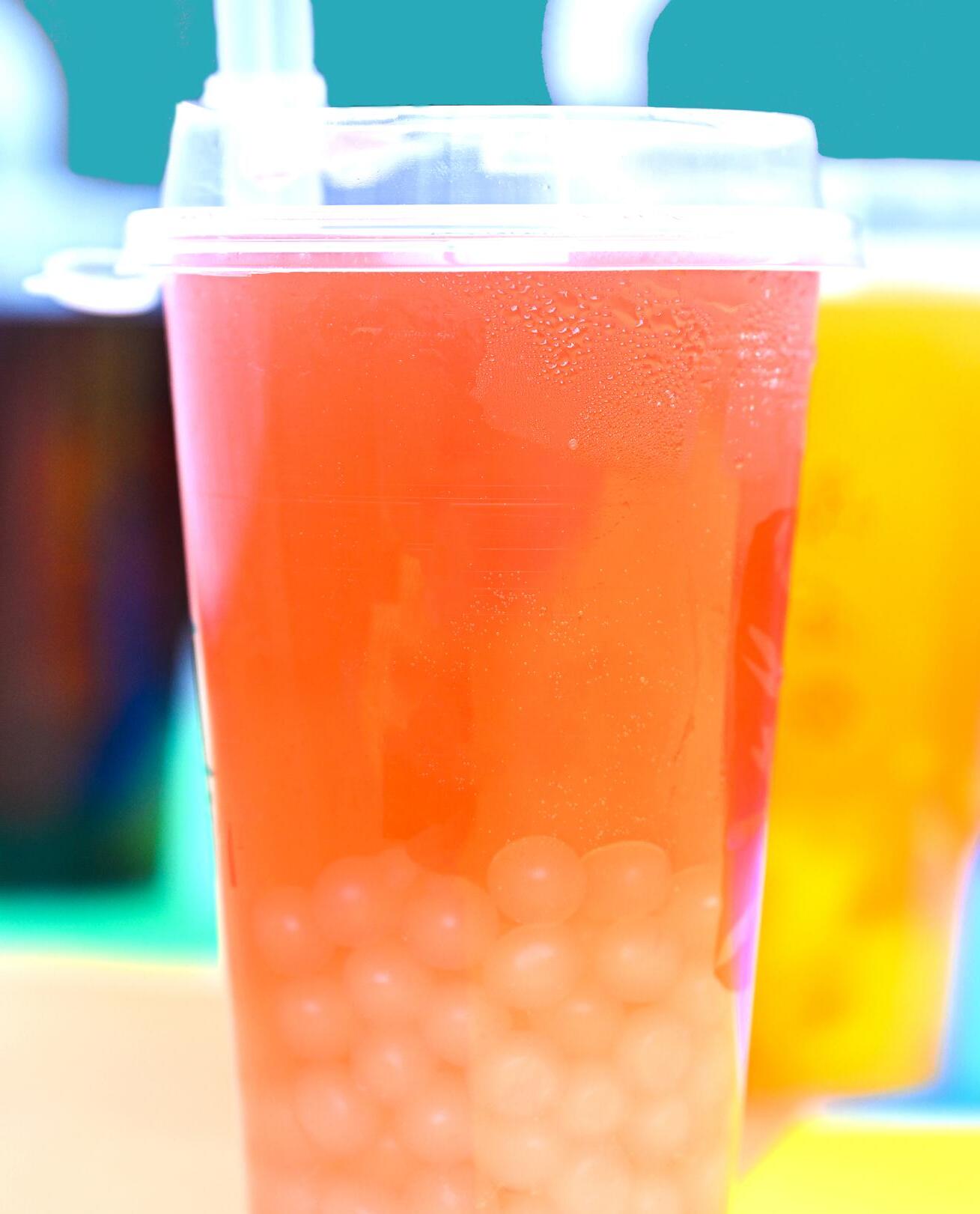
The ingredients are kept strictly secret. In order to make an objective judgement, we tried it. A tasting we would gladly have done without
by Michela Becchi - photos by Francesco VignaliAfter school the kids drank bubble tea, one might hum today, paraphrasing the far more noble lyrics from an Italian pop song dating back to 1972. Especially walking in the Pantheon area around lunchtime, where one of the capital"s most popular bubble tea shops fills up with children and teenagers in search of a refreshing drink. A beverage born in Taiwan in the 1980s, made with tea, fruit syrups and tapioca beads, fruit-flavoured gelatinous balls, to be drunk in transparent plastic cups that allow a glimpse of the floating pearls and the bright colours of the tall gulp drink, complete with a special straw (the bubble straw) to let the solid parts pass through. An eat and drink 4.0 food, with different elements to bite into such as the "natate jelly coco" or the "crystal jelly", with a more chewy texture. What are these made of? To be exact, we do not know, because at Tè Amo - bubble tea store with two locations in the centre of Rome, in Via della Palombella and Via di Torre Argentina - they did not show us the product labels (not even when we played the children with intolerances card...). A failed attempt also with distributors, such as Boba Space, a company supplying "American and Asian imported products" read on their website, from which we learn that they resell snacks of well-known brands such as
Reese"s, Doritos and Monster Energy energy drinks. And then syrups and bubble tea beads, which we tried to investigate, but the wholesaler"s response was blunt: «part of my job as a wholesaler is to hold on to the secrets of the manufacturers who worked to achieve that goal».

Entering said shops, however, it is easy to guess why they're so successful: colourful walls with drawings and stickers, an entire wall of post-it notes left by customers, splashes of colour everywhere and even the greetings board with Polaroid-sized photos signed by birthday guests. Pop to say the least, a technicolour dimension that also dazzles on the food front: bottles with syrups, chopped fruit and then the 'balls', the drink's peculiar bubbles. They all look a bit alike, these venues that capture the attention of the youngest: after all, we are talking about Instagram-proof environments (pardon me, TikTok, only admissable social media for Gen Z, between the ages of 11 and 26). When you cross the threshold of bubble tea stores, what strikes you most is the sweet smell. There are many flavours to choose from: there are the creamier Bubble Milk Teas






Hot black tea and tapioca pearls: this is the winning combination that gave birth to bubble tea, a beverage that originated in Taiwan quite by chance, a young product that has already undergone many variations. It appears to have been invented by Lin Hsiu Hui, an employee of Taiwan's Chun Shui Tang coffee shop in the 1980s, who accidentally dropped a piece of dessert into the tea. Not just any dessert, but fen yuan, a pudding made with tapioca balls, a starchy product derived from cassava, a plant native to South America and also cultivated in Africa and Asia. As often happens in the kitchen, a new trend was born from a mistake: the owner liked the beverage, so he started to include it on the menu. Today, bubble teas are conceived differently and have a worldwide spread, so that even the recipes are different in the various countries, where they are also made with heavy cream, fruit, coconut water, powdered flavourings or in the form of syrups, served in large glasses with special straws to leave room for the spheres to pass through. The strong point is always the same: the balls explode on the palate releasing all their juice.

From 'Galaxy' to 'Pompeii', 10 out-of-the-box tastings. Here's the taste of bubble tea. For the tasting we went to Bobble Bobble, a small Rome shop on Viale di Trastevere where we bought ten different beverages. Between 'special edition', summer flavours and milk teas, we also created our own beverage, choosing the tea base (black or green), fruit flavours (in syrup) and the pearls. What all the bubble teas we tried have in common is a pronounced sweetness that brings one back to childhood: the less romantic side, certainly not that of mum's homemade biscuits, rather a cloying industrial flavour. Sugar-coated jellies and hard orange and lemon wedge candies, American marshmallows and iced teas sold in plastic containers... a dip into a sensory past we could have done without. Worth forgetting, in short. Or rather, no, to remember: and thus avoid falling into it again!
1 Taro
It is the only milk tea (with milk, then) in the tasting, made from taro (a common plant in Asian tradition). The opaque violet colour is not alluring, but the taste dispels any doubts: it is among the worst bubble teas we tasted: sweet to the point of nausea, the pearls are particularly slimy and there is a bizarre hint of raw flour.
2 Galaxy
Dark in colour, it is a beverage with lychee, tropical blue (a vanilla syrup often used in drinks and slushies), blueberry, grape and 'glitter' (the usual fruit-flavoured tapioca pearls but added with edible glitter). The grape flavour is the one that stands out the most, but one can also detect a bit of blueberry juice - again, excessively sweet. The taste is artificial, nothing else to declare..
3 Cherry cake
Vanilla, strawberry and cherry flavours mixed together do not promise anything good. The result of this crazy mix is a melted candy (or rather, a cream and strawberry bi-flavoured bazooka bubble gum-like taste, to be precise). The pearls explode in the mouth without carrying any sour notes. Ready-to-drink candy floss.
4 Zen Garden
The "detox" bubble tea. Who knows, maybe it was named so because it recalls the taste of energy drinks so popular among sporty types. Or perhaps because it evokes the taste of powdered food supplements to be dissolved in water, with a vague hint of orange in the distance (we're talking long distances).
5 Blu celeste
Heaven in a glass is the claim of this bubble tea. It may be, but here one travels on not very comforting tracks, anything but a train to paradise. It is astringent, pungent, dark in colour as well as in its
aromatic notes, which bring forth dusty sensations.
6 Pompei
Lychee, orange and lemon are the flavours of the beverage, but it would be more correct to call it a liquid orange Tic Tac. The citrus is perceived in a disjointed, artificial, inordinate way. No more candy, please.
7 Green Iceberg
Who has never at least once tasted home-made iced tea made from powdered preparations? Here, the green iceberg is exactly that. What's more, it is also one of the least pleasant to the eye, with the green and orange spheres floating menacingly at the bottom. A metallic tasting finish rounds things off.
8 Valhalla
Mind you, nothing against candy, which makes everyone happy. But this extravagant liquid version does not work: again, there are hints of industrial sweets, which combined with unusual earthy notes create a profile that is not at all harmonious..
9 Bali
A drink that would like to recall the taste of the tropics. Somewhat, indeed, it does: scent and flavour are reminiscent of fruit juices and suntan oil. The hint of tea is present, but once again it is more like plastic container sweet tea.
10 Bubble tea custom
For the DIY beverage, we opted for a green tea base with watermelon and mint syrups, watermelon bubble balls and pomegranate bubble balls. The choice of mint is not accidental: the bubble tea is fresher and some of that sweetish taste is thus lessened. Overall, a rather light beverage, but still hard to drink from start to finish.
with milk, chocolate or caramel, or purple potato and taro, and then there are matcha and fruit options without milk. Each place has its own speciality, but the menus are more or less equally divided, and the price is around 5 Euro for the smallest size. At Tè Amo we chose a mango bubble tea: the menu reads 'jasmine tea, mango, assorted pearls, fructose', the label is missing but the fruit component is represented by a syrup (not a novelty, of course, but a customer has the right to know all the ingredients ingested). A cloying whiff arrives on the nose, which is also confirmed on the palate: the taste is really very (too) sweet (even though the mango drink seemed one of the simplest in terms of composition), it recalls unpleasant medicinal sensations. A little cough syrup, a little effervescent flu packets... but we have devoted a whole separate chapter to the tasting notes (spoiler: medicine aromas will return, along with candy notes).
One fact is certain: the growth that has been affecting the beverage in Italy for the past couple of years is not coming to an end. According to Ernesto Poccia, bubble tea distributor, it is very much linked «to the world of cosplay and manga, which are part of the same cultural background». A rapidly
expanding trend, as , marketing manager of Frankly Bubble Tea & Coffee, a chain founded in Milan but spread over several regions, also confirms, «there are currently 11 shops in all, but they will reach about 14 by the end of the year, mostly distributed between central and northern Italy«. The typical clientele? «Young people, around 12-13 years old, but also university students. And then children, accompanied by their parents who, intrigued by the novelty, decide to try the beverage» The best seller is the fruit tea, a tea base flavoured with strawberry, peach and various fruits, and then the pearls: here they use filtered leaf tea (a non-trivial detail) and then flavourings in syrup, but also fresh fruit. Whether one likes it or not, bubble tea is carving out a substantial slice of the market, so much so that it has been presented at trade fairs such as Sigep 2023, one of the most important events for professionals in the sector. Growth Capital - an advisor specialised in capital increases and finance operations for start-ups - in its latest report estimated that in Italy bubble tea has reached 42 million euro in value. From 156 specialised shops, the number has risen to 236 registered in March 2023. And on 30 April, Bubble Tea Day was also celebrated... a sugary and colourful toast in honour of Gen-Z's iconic beverage.

Nine menus in five years. He is really not afraid of challenges: Andrea Antonini, the young chef (born in 1991) at the helm of the kitchen of Imàgo at the Hassler Hotel in Rome, since 2019. His is a proudly Italian cuisine, revised and corrected, however, by cutting-edge techniques (Andrea's resume includes names such as Dacosta, Roca and Crippa). Craftsmanship, quality and whim. Lots of fun because the game, the surprise effect in regards to the guest, is an integral part of the proposal. Imàgo 9 is, as of today, the ultimate evolution of Antonini's culinary philosophy: a very technical but at the same time very direct menu, few ingredients on the plate, clear and recognisable flavours. The customer must feel at home. And so classic Italian-style aperitivo are served to start: chips, peanuts, olives and homemade crodino bitters. All very simple and straightforward, but watch out because nothing is as it seems. Dish after dish comes a crescendo of "is it or is it not?" But therein lies the beauty of sitting at a signature table.

Aperitivo
Snack
Scampi with green peppercorns
Raw beef garofolato
R Omelette
Calamaro milanese
Raviolo with crab
Roast lamb potatoes and herbs
Pre dessert
Rose, cream and wild strawberries
Mamma's cake donut, apricots, chocolate and vanilla
Petit four
WHERE IMÀGO DELL’HOTEL HASSLER
Rome
p.zza Trinità dei Monti, 6 06699347266
www.hotelhasslerroma.com/it/ ristoranti-bar/imago
SCORE IN THE 2023 GUIDE
Total 91
TASTING MENU PRICES
Per person, beverages not included € 210,00 the menu includes
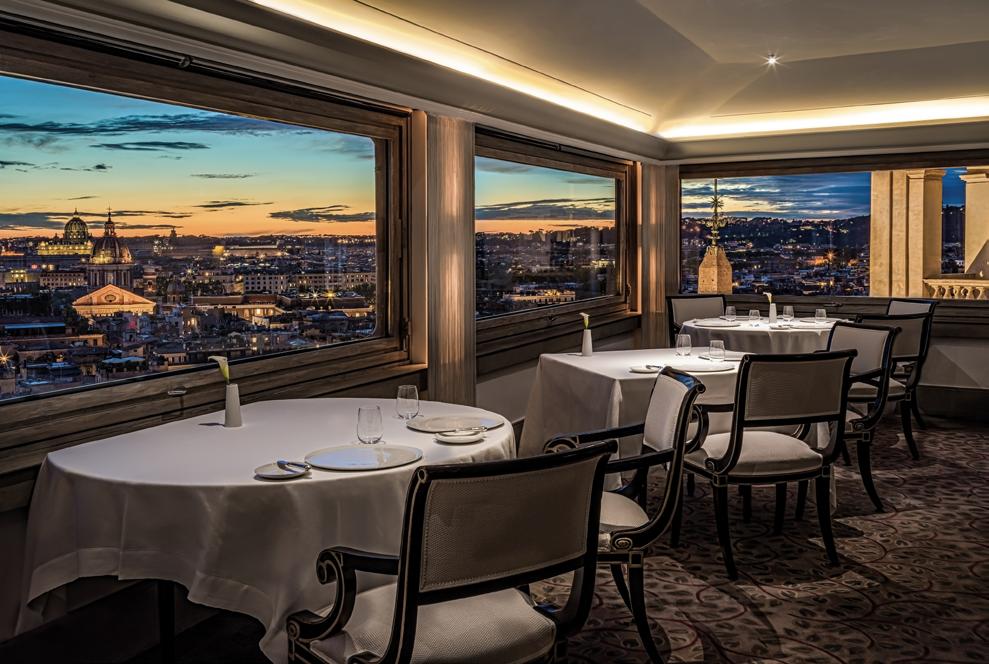 by Laura Mantovano – photos by Alberto Blasetti
by Laura Mantovano – photos by Alberto Blasetti
After aperitifs and snacks, Imàgo 9 starts with a tribute to a great hotellerie classic, green pepper fillet "revised and corrected" by the chef's creativity. The protagonists in this case are scampi, kings of the sea. Beautiful and meaty, these are treated as if they were a fillet, breaded with green pepper breadcrumbs, cooked in butter, and served accompanied by a mild green pepper mayonnaise and mustard oil. In the centre of the dish is a brown beef base in which roasted langoustine is infused, a brandy reduction and roasted green pepper are then added: another nod to the classic starting recipe.


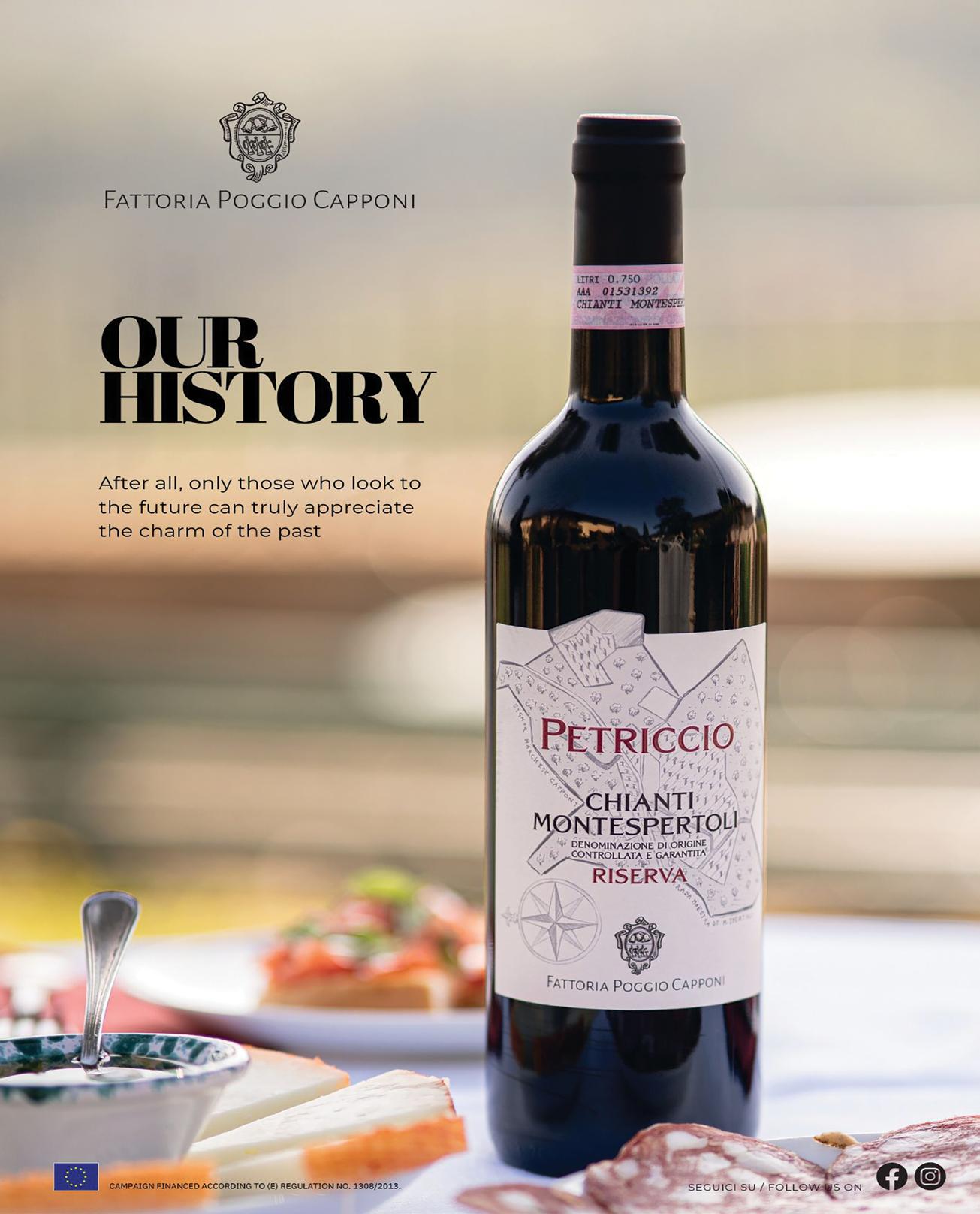
Antonini's "game" of playful changes continues: he takes an ultra-popular Roman recipe like garofolato, and turns it into an incredible summer dish. What is the exact opposite of a slow-cooked stew? Raw meat. Voilà garofolato 4.0: strips of fassona beef seasoned with cloves essential oil and enclosed between two crispy wafers made with brown stock, tomato, and cloves. Topping it all off is a quenelle of stewed vegetables accompanied by an emulsion, again made with the three basic ingredients, clove, beef and tomato.
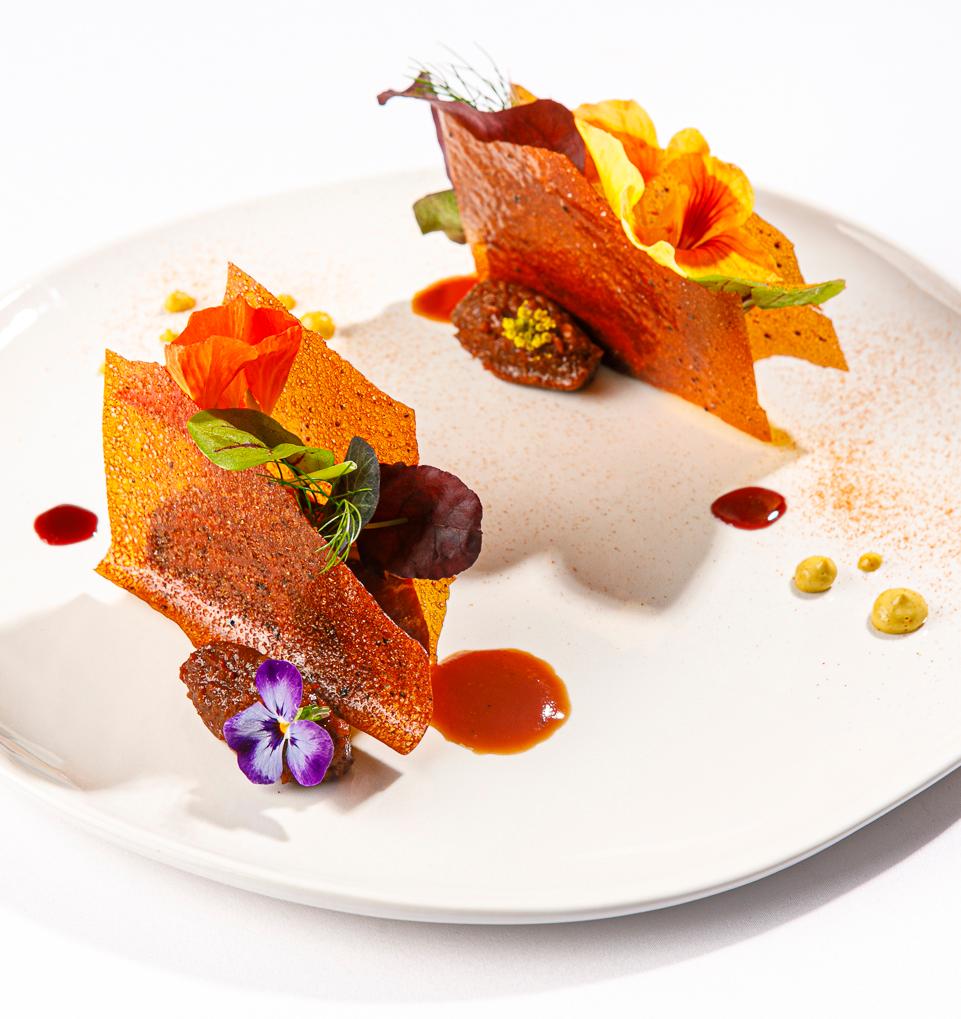
From Lazio to Lombardy. The source of inspiration this time is risotto alla milanese. Antonini removes butter, rice, and Parmigiano cheese and ... substitutes them with calamari. Reduced to a petit brunoise, the calamari are seared in a saucepan, deglazed with white wine, then emulsified with calamari broth obtained from the tentacles. Once plated, the rendered calamari pomade (risotto effect) is topped with a mock bone marrow obtained from whipped raw calamari, placed in a mould, then frozen in liquid nitrogen and then roasted in a pan so that it gains the appearance of "real" beef marrow.
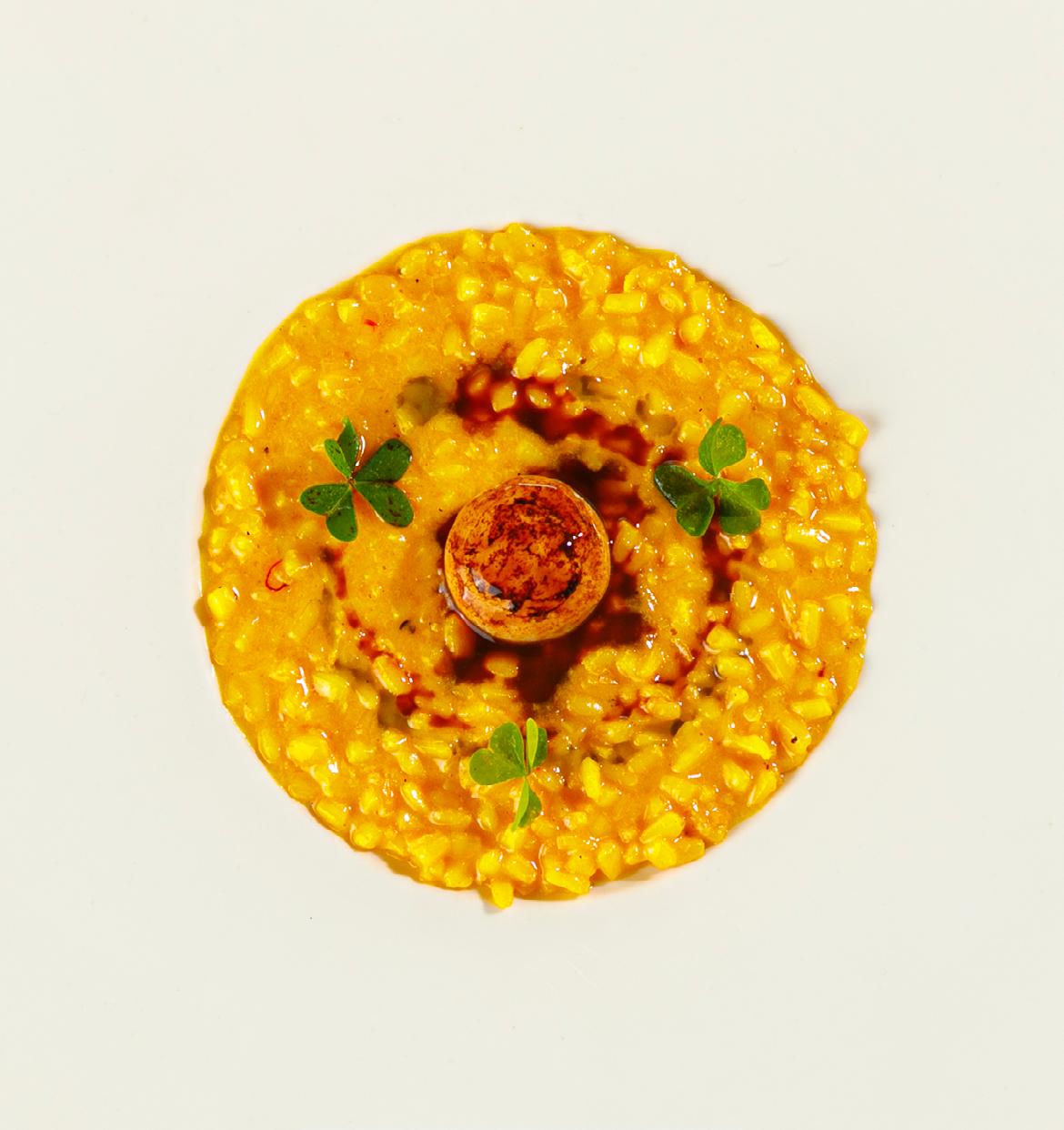
A fresh, summery dessert. Why not start with strawberries and cream, the emblem of the Italian meal ending from May to September, and work your way up to a variation? It was a nice challenge that Luca Villa, Imàgo's new pastry chef, jumped at. A soup of wild strawberry juice, lemon and red rose petal infusion serves as the base for a white rose petal compote with mint gel. This is topped with an almond cookie on which is laid a cream semifreddo enclosing a wild strawberry sorbet at its heart. The final touch is entrusted to a rose made of meringue petals built one by one. A masterpiece of detail, an incredible sum of techniques but when tasted, it is "just" strawberries and cream. And the guest feels at home.

GAMBERO ROSSO
www.gamberorosso.it
DIRECTOR
Marco Mensurati
SENIOR EDITOR
Lorenzo Ruggeri
PHOTO EDITOR
Rossella Fantina
LAYOUT

Chiara Buosi, Maria Victoria Santiago
TRANSLATION
Eleonora Baldwin
CONTRIBUTORS
Michela Becchi, Maurizio Gaddi, Laura Mantovano, Paola Mencarelli, William Pregentelli, Marzio Taccetti
PHOTOGRAPHS AND DRAWINGS
Alberto Blasetti, Yunus Boiocchi, Fabrizio Perilli, Francesco Vignali
Advertising
Class Pubblicità SpA
Milano, Via Marco Burigozzo, 5 - tel. 02 58219522 For commercial enquiries: kanchieri@class.it
Gambero Rosso and are registered trademarks belonging to Gambero Rosso S.p.A.
GAMBERO ROSSO is a Registered Trademark used under license by GR USA CORP
Copyright by GAMBERO ROSSO S.P.A. 2023. All rights reserved. Nothing may be reprinted in whole or in part without written permission from the publisher.
GR USA CORP is not responsible for loss, damage, or any other injury as to unsolicited manuscripts, unsolicited artwork or any other unsolicited materials.
july-august 2023
a www.gamberorossointernational.com
✉ international@gamberorosso.it f GamberoRossoInternational